
- Programmatic Advertising
- Deterministic Targeting
- OTT Attribution
- AI Modeling

Digital Audio
- Digital-Out-of-Home
- Local Sites
- Paid Social
- Paid Search
- Magazine Advertising
- Cover Wraps
- Industry Focus
- Insight Lab

Digital Advertising without Third-Party Cookies

Travel Marketing 101: Everything You Need to Know
People are ready to travel. Where, when, and how varies as much as the individual. Passion, timing, and budgets lead the way. A smart media strategy, combined with evocative storytelling, will transport consumers to your destination.
- What is Travel Marketing?
- Top Travel Industry Trends
Essential Travel and Tourism Marketing Strategies
- — Video Marketing
- — Virtual Reality Experiences
- — Augmented Reality
- — Increase Search Visibility
- — Content Marketing & Native Ads
- — Digital Audio
- — Personalized Messaging
- Big Data in the Travel Industry
Get Started with Travel Marketing Today
What is travel marketing and why is it i mportant.
- The Travel & Tourism market is projected to reach $54 billion in 2023.
- Revenue is expected to show an annual growth rate from 2027 of 4.41%, resulting in a projected market value of over one billion by 2027. 74% of this will be generated by online sales.
It's clear why travel marketing is important. Having a data-driven travel marketing strategy makes all the difference in overall business performance. It promotes travel services to new markets, strengthens awareness of one's brand, and increases the rates of both conversions and sales.
Just as travelers— for business or pleasure—have priorities and purpose in mind, so too should travel and tourism brands. What distinguishes your hotel from the others? What’s unique about your location? Who are your primary targets and how are you going to make their experience exemplary to earn their affinity? It all starts with defining your audience personas, crafting your brand, and knowing your KPIs.
Top Travel Industry Trends (2022–2025)
Again, how and where we travel varies, just as much as the destinations themselves. Below are just a few ways people are traveling. Understanding who is traveling where—and why—will inform strategies and personalization.
- Travelers Go it Alone : 25% of all American millennials plan to travel by themselves each year.
- Travelers Crave Local Experiences : The “experience economy” is huge in the travel industry. Consumers crave authentic experiences that distance them from mainstream tourism.
- Going Virtual : For consumers who want to sample and learn about different places without leaving their homes, there’s the alternative of booking a private tour and activity with locals around the world virtually, and viewing in the metaverse.
- Bucket List Travel: Always wanted to see an Emperor Penguin? There’s a cruise for that. Interested in seeing the beaches of Normandy? There’s a personal tour guide for that. Chances are the journey for these experiences starts with a recommendation from a friend and a good old-fashioned Google search to get the lay of the land.
- Business and Leisure Travel : Working remotely can mean Italy as much as Hoboken. The concept of being location-independent— traveling and working remotely— has become a new mainstay post-pandemic. In turn, digital nomads are searching for locations and deals on where to work and play.
- Sustainable Travel : Most U.S. travelers believe there aren’t enough options when it comes to sustainable travel. Nearly 70% of travelers say they are more likely to book accommodations if they know the property is planet-friendly .
Travel Industry Trends Resources: Generational Marketing 2024 Marketing Trends and Predictions
One of the best travel marketing tips to keep in mind is that most customers are not really paying for products or services in their minds. They are paying for experiences . As with nearly all businesses, technology presents the travel industry with seemingly endless opportunities to connect with customers. Below are just a few way brands are getting noticed:
Video Marketing
In the travel industry, videos have long been an indispensable marketing tool. They show off destinations and hospitality businesses in their full glory. Travel marketers that lean into video creation—and that doesn’t have to equal big budget productions—will forge connections with target audiences. Digital video is an amazing way for brands to educate, elicit emotion, and tell compelling stories.

Virtual Reality Experiences—The Metaverse and You:
It’s the ultimate test vacation. The metaverse can transport you just about anywhere and no passport is required. Like what you see? Post an offer and start planning. While still in the early stages, the tourism industry is already making the jump in the virtual reality (VR) world. Over the past few years, museums have introduced more creative ways to interact with exhibits and some have even taken consumers on pub crawls. Thomas Cook , a pioneer in the travel and tourism industry for more than 170 years, is using 360 VR films so travelers can test the waters of Sharm-el-Sheikh in Egypt and more. And if you’re trying to reach Gen Z, they’re here and they’re ready to go places.

Augmented Reality Enhances Real-World Settings
AR, or augmented reality, differs slightly from virtual reality. AR uses apps and overlays to create an experience and show additions to a particular setting. Travel companies can use this to advantage by using AR to transport and showcase their offerings.
Increase Search Visibility and See Bookings Soar
It’s easy to take the importance of a focused SEO strategy for granted with so many other options vying for your attention, but that would be a mistake. Not having a mindful search strategy as a key tenet in your media strategy would be like not seeing the Eiffel Tower when in Paris. A well-rounded SEO strategy facilitates direct bookings, drives site engagement, and increases overall cost-effectiveness.
Do it right, and you’ll see your Google rankings increase. Getting your brand name on the first page of results is the holy grail to success when 94% of search starts with a search engine and more than 25% click the first result that comes up.
While you may already spend on SEO, it's a good idea to have an SEO check-in from time to time to make sure you’re targeting the right folks and doing so the way they want you to.

Content Marketing and Native Advertising
Few things combine time and place to greater effect than native advertising. It’s the ultimate storytelling device, empowering marketers to say exactly what they want to say and where. A good magazine ad or digital native advertising piece will take the shape of an article—for example, by showcasing a vineyard in Napa on the cover of Travel + Leisure or a video highlighting the beaches of Mexico within a surfing site. The creative will transport viewers, and hopefully a nicely placed call-to-action leads to a website that will give audiences more of the information they seek.
A few native advertising tips:
- Create content that encourages the reader to act
- Know how you’re going to measure results: what is it that you want user to do after they read your article or play your video?
- Try to be original. If you are one of several players trying to host destination weddings, why should they pick you? Are you offering a special incentive code?
- Be authentic. Be real. Native content is storytelling, not overt advertising. It isn't directly selling, per se, but rather sparking ideas.
- Find a fit: Be mindful of where you’re running your creative and complement the space. It’s a curated audience you’re being seen in, so make the most of it.

For many, the first step to a journey is “hey Siri,” "ok Google," or “Alexa,” so it’s little surprise that increasingly travelers (and potential travelers) are turning to devices to book hotels or flights, and learn more about excursions and dining experiences. Markers can optimize content to capitalize on voice searches.
Personalized Messaging Enhances Customer Experience
The goal of effective advertising is to personalize messaging so it's as relevant and beneficial to the recipient as possible. If a travel brand is targeting a young family, it makes sense to highlight the activities for minors. If trying to become a bachelor or bachelorette destination, it may make sense to include in your ad the customized experiences available to enhance their stay (and perhaps a discount code). Leading with a customer-centric perspective distinguishes brands, creates affinity, and earns loyalty.
Data Draws the Big Picture: Big Data in the Travel Industry
The importance of data analytics to drive performance and ROI cannot be overstated and data visualization platforms play an important role in this. They—quite literally—provide a big picture of how all elements in any particular ad campaign are performing. Operators, in turn, can use this information to see what creative is performing strongest, and which platforms are driving the most visit to optimize performance.
Gathering the data enables travel and tourism entities to discern data sets and maximize budgets. Data visualization platforms, such as MNI’s industry-praised Optics , gives advertisers the ability to evaluate key metrics and optimize ROI.
- Engagement rate: How are people engaging with your content? Are they commenting, saving, and sharing, or merely scrolling past? If you have a million followers but only 1,000 interact with your marketing, that is not a great return on your effort.
- Targeting/Retargeting: Are your ads reaching new audiences and are you using data to re-engage potential leads or customers who leave your website without converting? Retargeting ads are designed to help advertisers reach visitors who do not convert right away. These campaigns are effective because they allow advertisers to target engaged customers with a highly relevant ad. Retargeting delivers strong results for increased awareness, website traffic, and conversion rate.
- Putting it all together: Let the picture of what you see tell you where you want to go, where you should be spending more, what ads you should optimize. For the effort that your business is putting into collecting and maintaining a database, you should be able to obtain an equal or greater amount of value from the insights it gathers.
Attitudes to travel are a moving target. Whether traveling for business or leisure, going by air or train or car, the desire to travel is real. Telling your target audience how you will be providing value and keeping them safe is essential. Step #1, know your audience. Step #2, connect with them. Step #3, embrace a multi-channel strategy. To do this, it’s incumbent to keep up to date with the very latest travel marketing strategies and to partner with those that do it best.

Travel SEO & Marketing

How do you implement an SEO and marketing strategy for your travel company that actually works?
You start with a business goals, reverse engineer competitors, and set realistic milestones.
SEO isn’t fast, and it isn’t easy, but it’s one of the highest ROI marketing processes out there.
The travel industry is awash with competition. Yet those that can market their travel company properly, and bring in new customers at a reasonable acquisition rate stand to make huge profits.
Huge OTAs (Expedia, Priceline, Kayak) spend millions on television and online marketing ads, while smaller outfits focus on a higher quality customer service. Hopefully, you’ve been able to carve out a niche for yourself to stand out from the crowd, if not there are a few ideas in here.
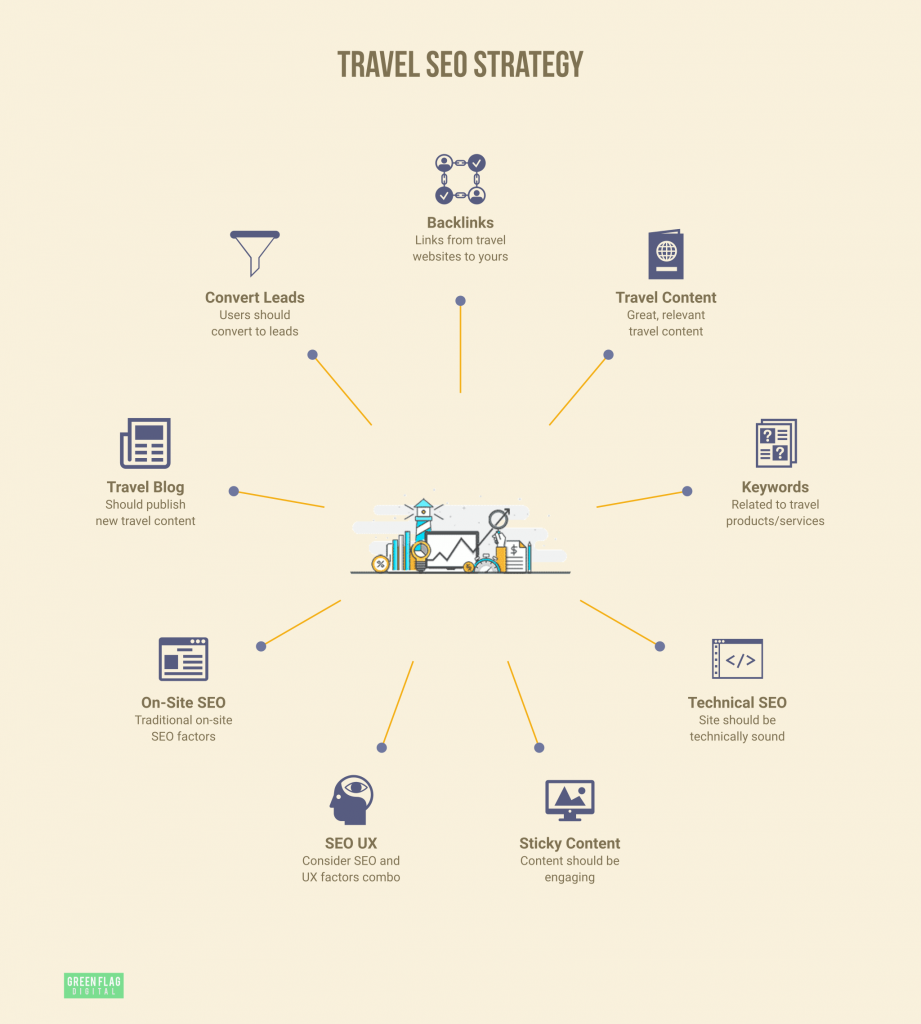
My goal is to quickly overview some key takeaways for travel marketing and SEO, and what’s working now.
What follows is general guidance that applies differently to different types of travel companies. Tour operators and flight scanners will have different business models. A local walking tour’s marketing & SEO strategy will be entirely different from a global hotel search engine. Be sure to build and craft your strategy based on the subindustry, maturity, and business model of your business.
Get clear on the value of SEO up front, and if it’s not a top 3 priority compared to your other opportunities, make sure you’re appropriating the budget accordingly. Said simpler, you should but 80-90% to your top 3 highest alpha generating marketing channels, but for your secondary and tertiary channels, don’t ignore them completely. See our SEO budgets post for more .
Travel Search Marketing
There are two categories of search marketing: paid search through Google AdWords or Bing ads, and search engine optimization (SEO). We focus on SEO so that’s what we’ll be talking about here.
What you want to think about with travel search marketing is the life cycle of a visitor. When booking travel, the journey is long and meandering. Visitors are crosschecking many sites at once, looking at pricing, quality, trust, efficiency, fun, and many other factors. It’s very complex.
Google did a study exactly on this and found:
“The modern customer journey is complex. So it’s important to focus on the key moments that can help inspire people to buy your product or service. We analyzed millions of consumer interactions through Google Analytics to show how different marketing channels affect online purchase decisions. What are the most important moments along the journey for your customers?”
When using their amazing industry-specific tool, they found this common customer journey for travel buyers:
What this means for you is you need to be there at ever step of the way, and have some form of content for the user. This applies at an overall digital marketing level, where you want to map different channels to different stages of the customer journey, but also even deeper on an organic search level.
Not all keywords are created equal. Although the diagram above shows that travel customers often start their journey with organic search, it’s present all the way through the process.
How do your potential clients find you in organic search?
If we look at travel keywords, we see that there are hidden meanings behind each one. Each keyword has a specific intent. Google is trying to find out what the user means behind each keyword, what they want to accomplish.When a prospective customer starts their search for a travel company, they start searching in general terms. As they narrow down their search, however, they get more specific and closer to the final buying moment. Here’s a quick example. Let’s say you want to go on vacation next summer. Here is a progression of searches you might find yourself using over the next 3 months as you plan and finally book your vacation:
- “best places to visit in 2023”
- “best countries to visit in summer”
- “best countries to visit in summer 2023”
- “best european countries to visit summer 2023”
- “itinerary for best european summer vacation”
- “best cities in europe to visit in summer 2023”
- “best european travel companies for couples”
- “goahead tours reviews”
- “kensington tours reviews”
- “goahead tours vs kensington tours”
- “kensington tours italy reviews”
- “kensington tours discount code”
In this quick example, we can see how over the span of a few weeks or months someone would start with broad ideas, and then slowly narrow down their search by deciding on a specific company and looking for that final discount code before booking.
In reality, the user may be doing dozens or hundreds of searches, opening many tabs at once and doing a deep dive.
There’s a deluge of information available to the modern traveler, and travel companies need to provide a matching deluge of quality content that is also optimized for search engines and humans.
What would that process look like from start to finish?
1) Here’s an example of keywords for a travel tour company selling tours in Munich, Germany:
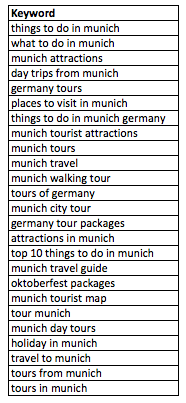
As you can see, there are a lot of keyword options. It’s hard to know where to start.
2) Which keyword is best? Well, we can look at two other factors: volume and cost-per-click (CPC). Volume means the amount of searches per month, and CPC means the price of the keyword, or what someone would pay per click in Google AdWords through their auction system.
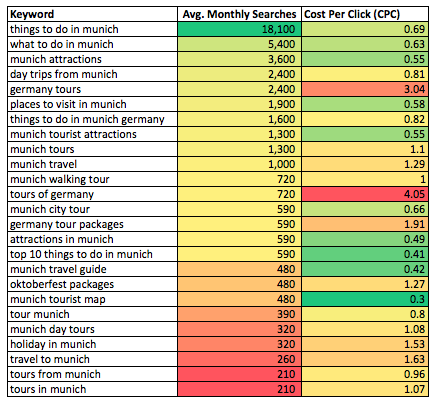
Now we’re starting to see where we can focus, and which keywords are more important than others.
3) But going even further and using this new info, we can now map customer intent & customer journey stages to these keywords.
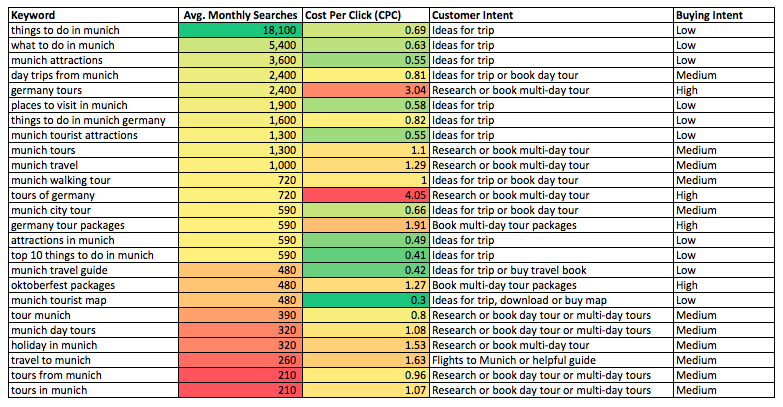
This exercise turns a list of 25 keywords from just “good-to-know” information to an actual report that maps to your marketing funnel.
4) Going deeper we can create actionable ideas based on these keyword. Using this info, we decide what content to create.
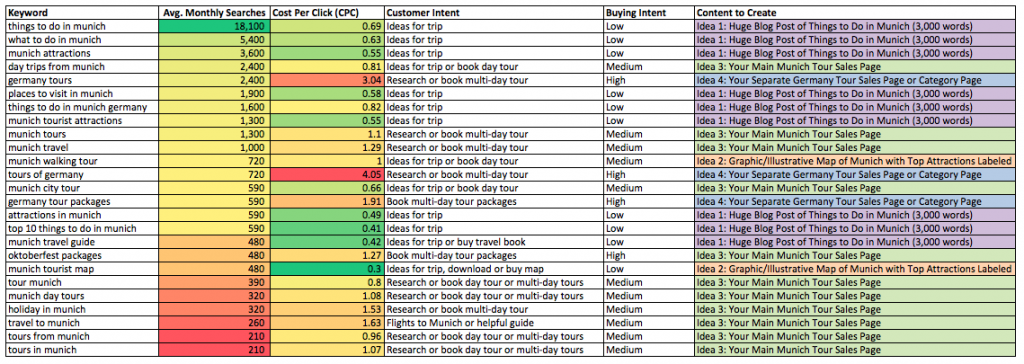
This is far superior to just a spreadsheet with a list of keywords and data puke. What we have here is a list of things to do over the next quarter. Content to create, keywords to track, and how it fits into the customer journey.
What’s the ROI for ranking for these 25 keywords? Is it worth going through this effort? Well if we multiply monthly searches by what advertisers are willing to pay, we get this:
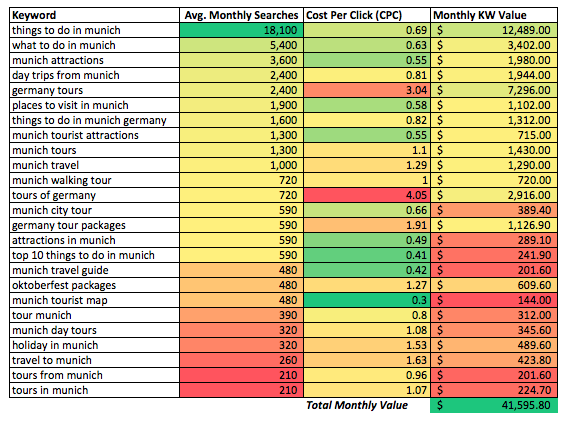
So for just these 25 keywords, there’s over $40,000 a month in organic traffic up for grabs.
Yes you can go deeper into this and analyze:
- Keyword difficulty
- Actual expected clicks for each keyword and basket of thematically related keywords
- Total search potential
- Cost to create each asset
- Resources needed to beat current competitors ranking for these terms
The list goes on, but hopefully this gives you a taste of the research involved, just to know where to begin. See more luxury travel keyword ideas here .
SEO for the travel industry is challenging. You must be thinking like the consumer, giving them what they want, integrate SEO with your overall content and marketing teams, show ROI, and also focus on the technical and behind-the scenes factors that can make or break your search strategy.
It’s tough, but with the right game plan and customized strategy for your site, it’s all about following the map and executing it well. And faster than your competitors do.
Breaking down travel SEO further, we can broadly speak to it in two ways: things you do on your website, and things you do off your website.
Travel SEO and On-Site Factors
If your travel brand has been around for a good while, has received press, mentions, links and decent traffic, then it’s likely you’ll want to put a lot of your focus onto things you can do on your website for quick wins.
Most every site has some low-hanging SEO fruit that can be picked for quick wins. A few examples:
- Take your top 5 organic search landing pages, find out what’s making them work, and add some core SEO improvements to make them even better
- Find keywords your top pages are almost ranking for (positions 11-20) and optimize for those additional keywords
- Add in better internal links throughout the site
- Take your competing pages and set them up so the most powerful and best converting page is the focus
- Bring together thematically similar pages with “content hubs”
- Test page title tags based on what is working in your paid search campaigns
- Rewrite title tags to evoke emotion for better click-through-rates
- Optimize pages for answer snippets by including succinct questions and answers on pages
- Create bulleted and numbered lists to try to rank for position 0 in search results with answer boxes
- Find no longer working redirects and dead pages and redirect them to new ones
- Optimize your XML sitemaps, robots.txt and more
- Improve site loading pages on most important pages
The list goes on and on and for each site it’s different. It depends on the size, depth, age, and theme of your site to know where to focus first. For huge travel brands that are relaunching their website design and/or platform, there will be hundreds or thousands of old pages to redirect. Conversely, a newer, more focused site will want to focus on improving the depth and quality of the few important traffic-driving pages on the site.
What makes SEO for travel websites both exciting and daunting is the pure volume of opportunities. There are so many searches for everything travel, that wading through the most important topics and keywords can be a full-time job.
With the right expertise and experience, however, one can quickly spot what’s worth optimizing and what can be left along.
Travel SEO and Link Building
SEO isn’t complete without talking about link building.
Unfortunately, link building is really hard in the travel industry because it’s so competitive. (SEO for the travel industry is hard or easy depending on the narrower niche, but link building is generally hard for all parts of the industry.)
What may work in other industries just doesn’t have the same success rates in the travel industry.
From my own testing, outreaching to travel bloggers and other sites with our well-designed infographic received a much more subdued response or a request for payment when compared to the same approach in another industry.
What this means is you’ll need to work harder and get more creative to really stand out. You’ll want to push the limits as to what you can create that is truly worth talking about and adds value.
For example, we put together this world map: Around the World in Perfect Weather for a client, and it was picked up by a software mapping company and a general interest men’s site, among others:
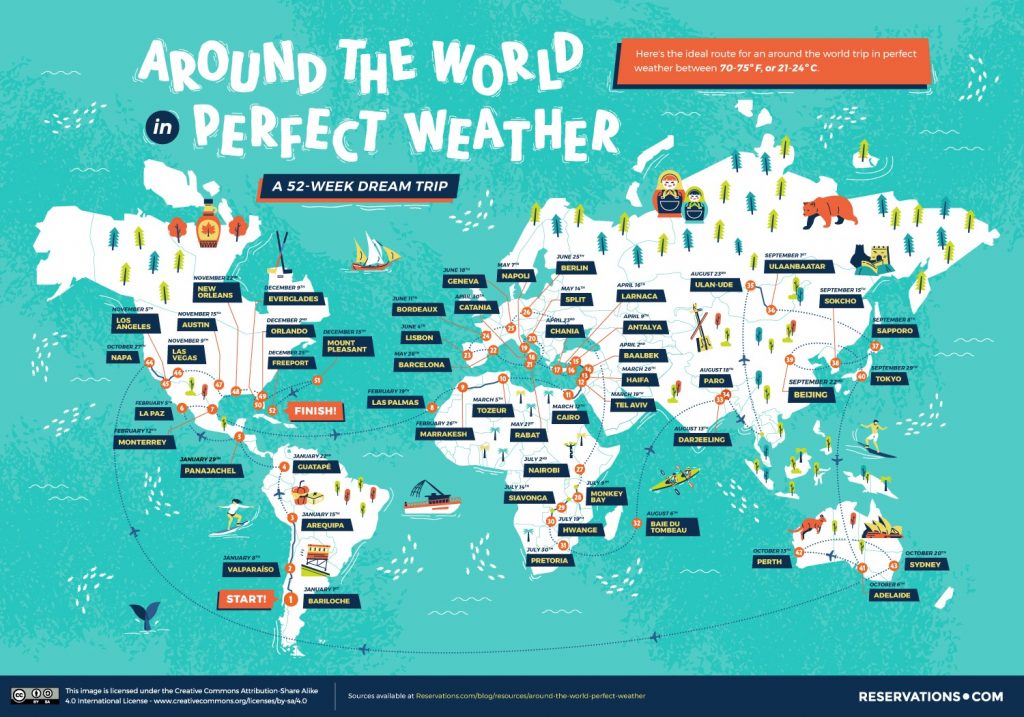
But in other cases, we found more success targeting security research sites, business productivity sites, or movie sites – but travel bloggers rarely link.
Quick refresher: the point of link building is to get other websites to link to your site. Whether they mention you in a blog post, resources page, feature you in an interview, share your graphic or video on their site, or a number of other ways, the goal is high quality links in a high volume.
So what are some examples of link building in the travel industry?
- Your CEO gets interviewed by the New York Times, Condé Nast Traveler, or some other huge outlet (this is the ultimate goal)
- A member from your team is interviewed on a podcast and gets linked to in the podcast notes
- You create an amazing data-driven infographic and bloggers want to include it in one of their blog posts
- You create a travel calculator that gets shared and linked to
- You create the ultimate guide to a certain event, type of travel style, or country that becomes the definitive resource and is linked to
- You guest post for other websites, linking back to your own
- You reach out to sites with resource pages to include a link to your best resource
- Your company gets listed on your partners’ websites
There are hundreds of other ways to get links. The key thing is to focus on quality, relevance, and ensure you’re getting enough of them. Oh, and you also don’t want to pay for organic links or engage in tactics against Google’s policies. If you have a brand that you care about long term, you want to stay safe with white-hat practices only.
Which leads us to the latest and greatest in the world of link building: digital PR.
Travel Industry Digital PR
Digital PR and travel content are actually a match made in heaven.
The travel industry was one of the first to embrace the original versions of content marketing and public relations.
Why? Audience size, trip size, and money.
If you think about it, almost everyone wants to
Where do you start?
Here’s a brand new video showing some approaches for generating digital PR ideas in the travel industry:
In it I cover:
- How Google News is the place to start
- What search terms to use to find campaign ideas
- Where recency search operator come into play
- How to spot the travel brand in the news coverage
- Why bigger publications are easier to land on than small ones
- Intro to some frameworks that are popular.
What About Travel Content Marketing?
Content marketing is a newer term, but the idea has been around forever. Perhaps more than any other industry, the travel industry has fully embraced content marketing earlier than anyone else.
Without repeating old stories, Michelin wanted to sell more tires so they went around rating restaurants in France and creating Michelin guides. They distributed these guides to customers, who became for familiar with their brand, which eventually resulted in more tire sales for Michelin. It worked.
Case in point, travel guides and brochures are a standard in the travel industry.
They’re not always a standard in other industries, like construction or teen clothing. But in the travel industry, content marketing is one of the oldest and time-trusted tactics.
So we know that content marketing is essentially creating interesting content related to your brand that you can promote for exposure and traffic back to your website.
When it comes to online content marketing for travel companies, here are some example types:
- High-quality blog posts on your company blog
- Guest posts on other travel blogs (hard to get but worth it)
- Infographics
- Instructographics
- Interactive infographics
- Visual data
- Product and service pages
- Long-form online travel guides
- Downloadable ebooks
- Email campaigns
The hard part is know where to invest your budget, when to do it, how to execute, how to analyze, and how to learn from your experience.
Additionally you’ll want to tie in content marketing with ROI. This has historically been difficult to do, but there are formulas and ways to analyze the content marketing piece to tie it in with actual revenue.
The goal of content marketing is to build up the visibility, traffic, and authority of your site. It indirectly affects revenue, as content marketing generally focuses on the top of funnel and middle of funnel visitors, with a small portion focused on bottom of funnel visitors before they are handed off to your sales or customer service team.
So how does content marketing relate to the other forms of marketing? Content marketing has a lot of overlap with search marketing, email marketing, and paid marketing, and they synergistically work together. They are all a part of your travel digital marketing strategy, which is then part of your overall travel marketing strategy. Hopefully that makes sense.
Travel Tour Company Marketing
We’ve spoken broadly about travel marketing, but what are some aspects that are more important for travel tour operators?
You Own the Client End Relationship
It’s both a blessing and a curse that you own the most important part of the travel process – making sure the client has the best trip possible.
Compared to travel agents, travel aggregator websites, booking engines, etc, the amount of contact and information you have on a client is gold. You have a much deeper and meaningful business relationship and can use that to your advantage.
You have their email address, phone number, preferences, and in-person conversations that you can use for future marketing and retention efforts.
An analogy would be purchasing a new espresso machine online:
- Google is the search engine that gets you there.
- You check out a bunch of websites, including brand websites, ecommerce stores, etc.
- You read blogger opinions and start narrowing down your list of options.
- Review websites further build the case and help you decide, eventually pushing you to…
- Amazon, where you purchase the espresso machine.
- The goods are then delivered by UPS to your front door.
Of all of these companies helping you get something, Amazon owns the end customer information, which makes their customer data and retention that much stronger. They have the strongest part of the relationship, and perhaps that why so many of us buy from Amazon on auto-pilot.
As a tour company, you have the ability to interact with and predict your customers wants and desires more than other travel businesses. Use this to your advantage.
Tour Operators Have Deep Knowledge of Destinations
As the tour operator – whether you’re offering daily walking tours of the Coliseum in Rome, multi-week Safaris in Africa, or luxury trips to the World Cup every four years – you have deep knowledge of the destination.
You know more than Wikipedia about your trip. More than the New York Times. More than travel bloggers.
This is your number one advantage when it comes to content marketing, SEO, and the trust that visitors will place in you. If you don’t transfer the knowledge in your head and internal documents to your public website, you’re missing a huge opportunity.
Google’s search engine is overweighting deep, thorough, in-depth content more than it ever has. Those that can provide the ultimate guide to their trips and destinations will be far ahead of the pack.
Old-school travel tour operators may not trust the power of the internet to drive sales. But you do, and you can use that trust in online bookings and leads to push your expertise online.
Consumers want to read everything online before they even pick up the phone. Be sure to offload as much information as you can divulge, design it in an enticing way, and watch the leads come in.
Travel Agency Marketing
From what I’ve read online, travel agents have faced a ton of competition since the rise of OTAs and the internet in general. What was once the best way to book trips has become one of many choices. That being said, travel agents still send a significant number of travelers to destinations around the world, and they’ll be around for a while.
To be completely honest, I wouldn’t bill myself as an expert in travel agency marketing, but from what I know from general travel and tour marketing there’s a few tips I think will help travel agents.
Focus on Depth Not Breadth
Speaking from the perspective of organic search, and new clients finding you online, it’s very unlikely that small travel agencies will be able to compete with the big boys.
It’ll be a long road for you to ever earn organic traffic for “tours to italy” – it’s just such a competitive term, and every Expedia and TripAdvisor of the world will beat you to it.
So instead of trying to earn traffic on a wide variety of topics, pick a few that you have a lot of expertise in
Refocus Your Website on Conversion and Design
It’s easier than every to have a well-designed, high-converting website built for you, but it’s still a process.
From my research, I see so many small travel agency websites with just really outdated designs.
I understand it costs money, time, and expertise to build and maintain a site. But what’s your alternative?
If you are depending on the internet to bring you sales, you must focus on your website.
Expect to spend a few thousand dollars to have it really well done. It’s an investment, and you shouldn’t be skimping on design.
If you’re not advertising on the radio or in phone books (and you probably shouldn’t be), make sure you’re directing that money to building your web presence, starting with your own site.
Write a Personal Monthly Email Newsletter
If you’re a small to medium sized travel agency, your unique selling point is the help and guidance of travel agents, as well as the custom attention you offer.
You can extend that to monthly email newsletters that are actually helpful.
If you simply chose one of your most popular packages every month and wrote a list of questions and answers, you’d be better off than 80% of email newsletters. Too often, these are boring, stale emails that just encourage the receiver to go buy something.
Be sure to offer your unique knowledge that no one else has.
What Makes the Travel Industry Different from All Others
1. travel marketing is seasonal.
Whether you’re focusing your travel services around specific events or specific destinations, there’s going to be differences depending on what you serve. When looking at your website traffic and leads, you have to keep this in mind and time it correctly. It matters more in this industry – more than many others.
You may look at search volume estimates for an event or travel destination this month and not be impressed with the metrics, but if you look at it over the length of a year, you’d be impressed when the monthly spikes come in. You can find this data with Google Trends and Google Keyword Planner. We also have a list of travel trends ideas here to get you started.
Pro tip: Capture Leads During News Coverage
News and media outlets focus on what’s happening now. That means if your event or trip is happening in 6 months, it’s unlikely to get coverage now. The coverage will happen when the event is going on. This changes depending on the nature of your business offerings, but seasonality is definitely important.
For example, I worked with a company that offered Running of the Bulls tours in Spain. That happens early July every year. Rather than seeing a traffic spike 2-3 months before when it’s the best time to book, often the traffic spikes happen during the event. Most of the traffic is from people who are reminded of the event and want to go the following year, so this is an absolute PRIME time to capture their attention. If nothing else, capture their email address so you can market to them 6-9 months later.
Reversal : In the dead of winter, you can bet that consumers are thinking about their warm summer plans, this is a given. So you also need to account for news and media covering topics in the present for planning future trips.
2. High Cost Travel Products
In regards to standard monthly expenses, traveling is expensive. Even if you’re just taking a plane to a nearby city for a few days, the vacation will cost a few hundred dollars. What this means is it’s a high touch sales process. Most every potential traveler is not going to call your company and book on the spot. It happens, but as the length and price of your packages increase, you should expense longer and longer sales cycles.
The key thing to understand, and many travel veterans may roll their eyes at this simplification, is that selling travel services online is much different from selling a book online. You can’t expect a one-call close, and you can’t expect most visitors to purchase a $4,000 package on your online shopping cart.
Pro tip: Allow Monthly Payment Plans
If there’s one thing we can learn from infomercials and car dealers, it’s that monthly payment plans work like gangbusters.
Many consumers don’t like to do math, so make it easy for them. Show them exactly how much they’ll be paying monthly, and suddenly that dream trip is a lot more affordable.
You can extend this even further by offering online calculators that instantly show them the pricing, and allow online deposits to be taken.
3. Consumers Will Do Thorough Research
Armed with the power of the internet and unlimited choice, consumers know more about your business than your friend does.
This means that your sales teams are no longer the only source of information as it was in times past. Which is good news because you’ll no longer be paying your sales and customer support to answer simple questions. But it also poses a challenge because you have to do more work to educate the customer about your offerings, or someone else will.
Pro tip: Answer All Questions with a Giant FAQ Page
One of the highest trafficked pages on a client’s website for a trip was their FAQ page. That’s because Google is rewarding long and thorough content, and consumers love this.
Right now, open up your email and find the 10 most common questions that prospective customers ask you about your travel products. Write out helpful 2-5 sentence answers for these questions, and post this on your website today. Track it for the next 8 weeks, and you’re almost guaranteed to receive new traffic to this page like never before.
4. Reviews are Extremely Powerful
Put yourself in a traveler’s shoes for a moment – you’re spending a lot of money and time, taking off work, rearranging the family’s schedule, and much more – all to have a little bit of fun. Do you want to risk all of that on a company that has so/so reviews? Most likely not.
What this means for the company, is you have to believe in your product, and take care of your customers to the extreme. You also need to engender brand loyalists and brand advocates as much as possible.
There’s a challenge with certain platforms like Yelp that may hide your best reviews and only show negative reviews. This is a challenge that many businesses face, and we just have to work harder to overcome this.
Pro tip: Make Requesting Reviews Automatic
Are you automatically asking for reviews after a trip is complete? You can do this with your marketing automation system. It will take a bit of planning and configuration, but you can set up an automated system where two weeks after your client returns home from their trip and is all settled in, they’ll automatically get an email from you asking about their experience and if they can leave a review.
5. Trust is Key
Are you responding to calls and emails as fast as possible? Are you walking customers through the process? Are you empathetic to their needs?
Relating to the reviews, customers essentially trust you with their life, depending on the location. They trust you not to sign them up for a dangerous tour, sketchy hotel, or non-tested restaurant.
They trust you to put their best interests in mind. It’s a lot of responsibility, and we need to remember that always.
Pro tip: Show Trust Symbols on Your Website
Trust symbols are awards, badges, or even anti-virus software logos that help consumers trust your website and brand a little bit more.
It also includes micro-copy: helpful little informational text that guides them through the process of booking and requesting quotes on your website.
6. This is a Discretionary (Yet Fun) Purchase
When times are tough, consumers tighten up their spending. Although we may view travel and vacation as a necessary part of life, many who are watching their budget will cut out travel before they cut out alcohol or gambling, for better or for worse.
So when the economy is good, travel interest may soar, but when the economy is in a downswing, it can really hurt travel operators and agencies.
It’s important to plan for this, be aware of the economic conditions, and tailor marketing and products to react to the overall macroeconomic environment.
Pro tip: Use Analytics Tools to Determine Your Demographics
You may have a good sense of the demographic profile of your current clients, but is there a hidden audience visiting your web properties that you’re not aware of?
Using tools like Google Analytics, Segment, Mixpanel, Facebook’s tracking pixel, and others, you can get rich demographic information that will help you understand your risk level for economic turbulence, and how to plan for this.
7. Market Disruption and New Opportunities
What was popular then isn’t as much now. In the 1980s no Americans dared venture to vacation in Vietnam or even Thailand, today both locations are growing rapidly.
World markets are opening up yearly. Cuba is open today when it was absolutely closed off only a year ago
Beyond the binary opening and closing of countries are lifestyle decisions. Tour companies dedicated only to athletic tours are growing. There are tour companies dedicated only to the largest bucket list events around the world, or obscure annual celebrations.
You can use the principle of the first-mover advantage to be the first to act on these opportunities and grab market share before your competitors do.
Pro tip: Use Google Trends to Predict Demand
Google Trends is the pulse of the internet. It graphically displays what’s trending and what’s dipping in consumer search demand. Keep an eye on your space and the new opportunities popping up with this tool.
When you spot an opportunity, you can test market response by throwing up a landing page or blog post and keeping an eye on web traffic.
8. Consumers are Cutting out the Middleman
Just like travel agents have seen a drop in numbers since the advent of online discounters, consumers can probably cut out your service eventually. As foreign countries become more industrialized and globalized, consumers might be less afraid to do it on their own, and book their trip directly with locals at a fraction of the price.
The counterbalance to this is to offer something they can’t put together on their own. Is it your local guidance? Do you have connections they can’t get? Access they can’t get? Extra amenities to make it all a more seamless process?
Pro tip: Use Surveys to Determine the True Advantage of Your Service
What you think is the most important part of your service may be wildly different from what your customers value.
You may think that your access to difficult to acquire tickets is your differentiator when in reality your customers just want to have a good time and get perfect service. Or it may be the opposite – you’ll never know without polling your customers.
9. There Are Emotional Components to Purchases
I’ve heard reports from the field of tour participants saying they would pay double the price for what they received on the tour. What was it? Convenience and ego.
A tour guide took a video of a tour participant Running with the Bulls and the participant wasn’t aware of that. Afterwards when they saw the video, it blew their mind. If you’re leading tours can you take photos and videos that show the tour member doing something they want to post on social media? That’s the ultimate proof.
During the same event, we provided access to the front of the line for the running of the race. While everyone else had to wait on the streets for two hours, our members were drinking coffee and enjoying the view. Can you provide that level of access to something that your customer can’t get on their own?
Pro tip: Surprise and Delight
“Under-promise and over-deliver” may be an overused expression, but it’s rooted in human nature. If you can think of one or two extra perks to deliver to your clients that they weren’t expecting, that could be the kicker that brings them back to you next year.
10. Social Media Infiltrates
Social media grew rapidly for a few years there and was only a novelty in the beginning. Now we can’t ignore it. As it matures it becomes more and more a part of consumers’ decision cycles, another outlet for information and research. They may not purchase directly from social media, but if you can gain more exposure by being in more places at once, well that counts for something.
Pro tip: Don’t Try to Use all Social Media Channels
For advanced travel organizations, yes you’re expected to be everywhere all the time. But for organizations in the growing stages, you don’t have the expertise or bandwidth to tackle all platforms at once.
Go to where your audience is, and focus on that social platform until you’re the expert, then move on. If your clients are older, focus on Facebook. If they’re younger, focus on Instagram. If they’re teenagers, focus on Snapchat.
There’s no perfect answer for everything, but think of your audience first, and meet them there.
Travel Email Marketing: A Complement to SEO Traffic to Retain Visitors Long-Term
If you acquire emails of past and potential customers, you’re sitting on a gold mine of value. Estimates peg the value of each email address at $40, but if properly nurtured, they can be worth much more in the travel industry.
One of the best things we’ve done on travel websites we’ve worked on was to implement an end-to-end email marketing program. This program included both traditional email broadcasts (some call it “blasts”), and email marketing automation.
Travel Email Marketing Automation
One of the best ways to stand out is to be top of mind in your customers mind. Email marketing automation makes that much easier than the past.
Email marketing automation allows you to send the right email to the right person at the right time. Let’s put together a hypothetical list of people as well as their preferences:
As you can see from our very small sample size, every person is different, but with the right email marketing tool, they can be grouped, tagged, categorized, and sent the right email at the right time.
You could divide them all up into different lists based on their location preferences, travel frequency, budgets, and email preferences.
When you hear the term “big data” in the news, this is part of it in a small way. You may not be analyzing billions of data points, but you’re using the available tools out there to learn as much about your customers as possible so you can serve them in the best way.
When it comes to email marketing for travel companies, focusing on the right email to the right person at the right time is more important than any other industry.
Tying it all Together: Travel Marketing Automation
There are so many moving pieces, things to remember, and subtle details needed to build out a smooth travel web marketing campaign from start to finish, that it’s almost humanly impossible.
Thankfully, software companies have helped us solve this pain with marketing automation tools.
Note: this section can get a bit technical and advanced, so if you’re just starting out you can bookmark this for later after you’ve applied all the online travel marketing basics.
If you think about it, your website is like a 24/7 salesman. It’s always working, always providing information, always ready to collect contact details.
But there are a lot of things the website can’t do that you need humans for. It can’t send out emails, can’t follow up with more information, can’t help qualify a lead to determine if it’s a good fit, can’t schedule a call in your calendar.
What helps fill in the gaps between your human marketing and sales staff and your “dumb” website is intelligent marketing automation.
Marketing automation sounds like a scary word if you’ve never heard of it, but in reality these are the most important tasks it helps accomplish:
- After a lead fills out a form, automatically have an email send to them addressed to that person by name, custom tailored for the trip they are interested in
- Automatically follow up with a lead within 5 minutes of them filling out a form, asking them to answer a few more questions
- Recognizing when a past customer is revisiting your website, so your sales team knows when to send a friendly check-in email
- Deliver brochures and downloads via email once requested, then follow-up after a 2-day delay providing more information
- Connect your marketing software with your sales CRM so your marketing and sales teams are sharing customer details (never have that embarrassing email mistake)
- Automatically schedule calls on your calendar with automated follow-ups
As you can see, marketing automation software helps eliminate the most redundant, yet still important tasks. If you like answering emails at 3 AM in the morning instead of having software do it for you then I suppose you can do without it, but most marketers have welcomed this technological advance with open arms.
There are many different software services for marketing automation, here are a few of the top services:
- Entry Level: ActiveCampaign, HubSpot Marketing Free
- Mid-Level: HubSpot Pro, ActiveCampaign Enterprise, Center-LeadPages-Drip (one company), Zoho
- Enterprise Level: HubSpot Enterprise, Marketo, Pardot
There are countless other contenders that you can find with some research, but my top recommendation if you can afford it is HubSpot or ActiveCampaign.
If you’re on a budget and just starting out, ActiveCampaign or Drip is the best way to start, although HubSpot’s Marketing Free options is great if you plan on upgrading to HubSpot in the future.
Marketing automation is fairly new, but it truly is the future of digital marketing. There is a deluge of content being produced daily that we now have to compete with, there are more marketing technology offerings than ever, and our visitors have higher expectations than ever before. Without a grand strategy in place, we’ll miss a lot of opportunities, and your marketing automation software sits as the hub of that strategy (along with your brain).
Want to Learn More?
If you’ve found this helpful, I’ll continue writing more on travel marketing ideas and strategies.
I’m also available to take on a limited number of travel marketing clients monthly. Currently, I have two openings. If you’d like to hear what that entails, simply contact me here .
I’m also available to take on a limited number of travel marketing clients monthly. Currently, we have two openings. If you’d like to hear what that entails, view our travel SEO services page.
- Full Name * First Last
- Website URL
- What are you interested in? Digital PR services SEO services Partnership Other
- Where did you hear about us? *

Request a Proposal
Fill out the contact form and one of our strategists will reach out to you via email to schedule a short phone call consultation to discuss your business.
Drop Us a Line
Let’s Craft Your Campaign
- Full Name *
- Email Address *
- Company Name *
- Company Website *
- Digital Strategy
- Performance Media
- Full Funnel Network
- Organic Social
- Media Creative
- Anything else you'd like us to know?
12 Travel Marketing Strategies To Help You Out-Market Your Competitors in 2023
Kyle Morley
January 26, 2023

The world of travel has evolved, especially after the COVID-19 pandemic in 2020. Travelers are valuing their time off more and researching more heavily before making travel decisions. Additionally, brands are competing to drive bookings and increase revenue to make up for the large losses the industry took in 2020.
Utilizing new and unique marketing strategies can help travel brands separate themselves from the competition, reach new audiences, and increase bookings. Take a look at our top 12 marketing strategies that can help travel brands stand out and out-market their competitors.
What Is The State of the Travel Marketing Industry in 2023?
The travel industry took a huge hit in 2020 with the emergence of the global COVID-19 pandemic. Both domestic and international travel stopped almost overnight, leaving the travel and tourism industry with little-to-no business. However, over the past three years, the industry has steadily increased to semi-regular rates, though still slightly lower than 2019.
According to the International Air Transport Association , global air travel is expected to make a full recovery by 2024. Additionally, the IATA expects domestic air travel to increase by 3% in 2023 compared to pre-pandemic levels in 2019. With that being said, many travel companies are looking to dedicate time and resources to out-marketing their top competitors and return business to pre-pandemic levels.
12 Travel Marketing Strategies For 2023
Using a combination of tried-and-true marketing strategies and unique ideas will offer a fresh foundation for travel destinations to attract new tourists and increase bookings. In 2023, the way consumers make travel decisions has changes. People are valuing sustainable travel options and relying heavily on social media and video content to make their travel decisions.
Luckily, we’ve compiled a list of 12 key marketing strategies and tips to help travel companies increase bookings and drive consumers to their destination.
1. Create A Seamless Website Experience
All of your marketing channels will be driving traffic to the same place – your website. If the user experience is lacking, it could drive away potential customers or have them book a stay with a separate OTA.
As direct bookings become increasingly important for travel companies, a seamless user experience on the website is of the utmost importance. A travel website should showcase all of the best things about the destination to really show consumers what their vacation will be like. Additionally, users should be able to seamlessly book travel experiences directly from the site.
2. Publish Blog Content on a Regular Basis
Blog content is a great way to capture the attention of untapped audiences and focus on search engine optimization. By creating content that targets highly searched keywords in the travel space and keywords specific to your destination, brands can dominate the search engine results page.
Not only does long-form editorial content help put a brand in front of new audiences, it also showcases the beauty of your travel destination. Consumers want to learn a lot about a destination before traveling there. According to TripAdvisor , consumers will spend an average of four weeks researching their travel destination. With blog content, brands can create a high quality resource for consumers to turn to throughout their research process.
3. Lean On Your Customer Reviews
Consumers are spending more on travel now than ever before. According to the ASTA , 40% of consumers are spending more on travel now than they did before the pandemic in 2019. However, consumers also want to be sure that their money is being spent in the right place.
Traveler reviews are some of the most valuable pieces of content that brands can use in advertising. Sites like TripAdvisor and Yelp are growing increasingly popular and can make or break a travel destination. By showcasing positive experiences that other travelers have had, brands can increase social proof and gain trust with new customers.
4. Upgrade Your Social Media Game
Social media is an integral part of any marketing strategy for 2023 and beyond. With the growing popularity of platforms like TikTok and Instagram, travel companies can leverage their social media following to increase bookings and drive traffic to other marketing channels. Regularly posting content and engaging with your audience is incredibly valuable for companies in the travel industry.
Influencers are also a key part of a social media marketing strategy. Utilizing influencer content allows you to reach completely new audiences and showcase the best parts about your brand and vacation destination. If you are looking to increase your reach with photo and video content, social media marketing is the best way to do so.
5. Rely On Data for Key Insights
Data is everywhere – you just need to know how to track it properly. Between websites, social media, online advertisements, and more, there is an abundance of consumer data that can be used to optimize your marketing strategy.
Travel companies can track user behavior, see where high-converting consumers are coming from, and see what marketing strategies are currently working. Using this data to further improve and optimize your marketing efforts will provide unbeatable insights and deliver quality results. However, you need to be confident that the data you are using is trustworthy and accurate.
6. Don’t Underestimate the Power of Remarketing
Remarketing is a powerful tool that can help direct audiences to your travel website or destination. A customer journey, especially in the travel space, can include tons of different searches and websites.
Remarketing may prove to be one of the most valuable tools in your marketing toolbelt. When consumers are more familiar with your brand, they may be more receptive to advertisements. Additionally, consumers may be more likely to convert after visiting your website more than once.
7. Improve Your Mobile User Experience
With the advancement of smartphone technology, consumers are starting to rely heavily on the mobile experience instead of a desktop experience. Travel brands need to shift their focus to the user experience from a mobile standpoint. Whether that means a quality mobile app or website experience can vary from brand to brand.
According to a study performed by SalesCycle , 44% of travelers will book their vacations online. Additionally, those booking on a mobile app or mobile site have a lower cart abandonment rate compared to those on desktop. Mobile consumers are becoming more and more valuable as the travel industry evolves. It is important to ensure that your brand has a seamless booking experience for both desktop and mobile users.
8. Utilize Email Marketing Campaigns
Email marketing is one of the oldest marketing strategies in the book. It continues to be a helpful tool for travel marketers to increase bookings, get more eyes on their destination, and actively engage with their audiences.
If you have an email list of consumers, you should be utilizing it! And, if you don’t, you should start building one. Including a simple spot on your website for users to input their email address and some basic personal information will allow you to organically grow your list and engage with your audience organically.
9. Use Video To Enhance The User Experience
As consumers are changing the way they research for a big vacation or small weekend trip, video is becoming more and more popular. Users like to feel like they’ve traveled to a destination before they have even left their house. Video is a great way to market your destination as highly desirable and fun.
Travel brands can either create their own video content, use consumer created content, or rely on influencers to create video content for them. Each type of content will provide it’s own unique benefit from a marketing perspective.
Branded video content created internally will be a great way for travel companies to interact with their existing audiences. These can actively be promoted on social media accounts, through email, and on the brand’s website. User generated content will appear the most organic and allow you to interact with your consumers’ networks. Influencer marketing videos may not be as organic as user generated content, but it will reach the widest audience.
10. Introduce New Technology To Your Marketing Strategies
New technologies in the travel industry are constantly evolving and are a great way to revitalize your marketing efforts. While AI Chatbots have been popular in the industry to assist with online bookings and answer quick questions from customers, the technology has majorly evolved since then. Outside of automated FAQ responses, AI can really have an impact on travel marketing.
There are AI technologies out there that can make personalized travel recommendations for tourists, can interact with consumers via voice throughout their vacation, track and trace baggage via image, and more. With so many new, AI-driven technologies emerging in the travel industry, it is important for brands to stay ahead of the curve to ultimately create an ideal travel experience.
11. Engage With Local Audiences Too
Local audiences may not seem that important to the travel industry, but they can be an additional untapped audience to target with marketing campaigns. While you may think that locals are familiar with the travel and tourism destinations in their area, you may be surprised to see how many have not visited.
Not only an this help you encourage repeat visits to your location, it can also help unlock untapped audiences. Successfully marketing towards locals may seem like a difficult task, as they likely try to avoid the tourist areas of their home. However, offering discounts to locals may help encourage increased attendance and may help your local marketing campaigns gain traction.
12. Tell A Story with Your Destination
Consumers want to travel to a destination with a unique identity and a clear story attached to it. In order to have a successful travel marketing campaign, travel brands need to do more than just showcase their beautiful destinations.
Every destination will have a unique identity and a unique story attached that can really help consumers picture themselves vacationing there. Whether marketers decide to lean into their destination’s rich culture and history, beautiful, calm scenery, or booming cities, a unique story will help travelers make their decisions easier.
Refresh Your Marketing Strategy with From the Future’s New Travel Marketing Platform™
Travel marketing can be a complicated undertaking. With that being said, it is important for travel companies to rely on expert marketers to help them understand what strategies are best for their brand.
At From the Future, we have over a decade of travel marketing experience and have used our expertise to change the way you see marketing. With our Travel Marketing Platform™ , marketers can access brand new audiences and tell their unique story. Get in touch with one of our specialists to see how the Travel Marketing Platform™ can revitalize your marketing strategies.
Share This Article:

How to A/B Test for Free with Google Tag Manager, and Any Marketing Analytics Tool.

Look What You Made Me Do: Lessons Direct-to-Consumer Brands Can Learn from Taylor Swift

Want strategy customized for your business?

Content Marketing Strategies for Travel Websites That Work
As the owner of a travel website, you know that content is king. Engaging, informative content keeps visitors on your site, builds your brand, and drives conversions. However, creating enough high-quality content to satisfy search engines and readers is challenging. This article on adventure landing pages will explore proven content marketing strategies tailored for travel websites that you can implement to boost traffic, improve search engine optimization, build your mailing list, and increase sales. Whether you're just launching your travel site or looking to revamp an existing content strategy, these techniques are sure to capture the interest of travel enthusiasts and keep them coming back for more. With some planning and persistence, you'll gain a loyal readership and watch your business take off.
Content Marketing Strategies For Travel Websites
As a travel website, your content is key to attracting and engaging visitors. By implementing effective content marketing strategies, you can build authority, increase traffic, and boost conversions.
Focus on High-Value Content
Provide useful information that answers your audience's questions and addresses their needs. For example, publish ultimate packing lists, city guides, reviews of lesser-known destinations, or roundups of budget-friendly travel gear. This high-value content gives visitors a reason to return to your site again and again.
Optimize for Search Engines
Use keywords in your page titles, URLs, headings, and content. Include location names, activity types (e.g. adventure travel, luxury resorts), and phrases like “things to do in...”. Place important keywords towards the top of your content. Also, interlink to related content on your site. All of these on-page SEO techniques will help search engines find and rank your content.
Build Links
Reach out to other travel websites, blogs, and influencers to build quality backlinks to your content. Guest blogging, link exchanges, and influencer marketing are effective ways to gain more external links while also increasing referral traffic and brand awareness.
Engage With Social Media
Share your content on platforms like Facebook, Instagram, and Pinterest to increase social traffic. Engage with your followers by posting eye-catching photos, running social contests and giveaways, and starting discussions. Build relationships with social influencers in the travel niche to gain more exposure.
Continuously Improve and Expand
Revisit old content to update facts, refresh designs, improve SEO, and add or remove details as needed. Look for new topics to cover based on search trends and your audience’s interests. A blog with a large, varied content library has more opportunities to rank well in search engines and provide value to readers. Continuous optimization and expansion of your content marketing will drive the best results.
Using Stories to Connect With Your Audience
To connect with your audience, tell stories about the experiences your company offers. Describe in vivid detail what visitors can expect, highlighting things that make the destination unique. For example, discuss the local cuisine, cultural attractions, natural scenery, outdoor recreational activities, etc.
In addition to written stories, include high-quality photos and videos. Post compelling images of the location and activities on your website and social media. Create short video clips showcasing the sounds and sights. These visuals allow people to imagine themselves in the place you're promoting.
Affiliate marketing is another way to leverage stories. Partner with local businesses, tour operators, hotel chains, and activity providers. Ask them to include information about your destination on their platforms, and offer to do the same for them. Cross-promotion expands reach and fosters mutually beneficial relationships.
With stories and affiliate partnerships, you can tap into the enthusiasm others have for travel and adventure. People who are passionate about a location or activity are often eager to share details and recommendations with their own audiences. Leverage their stories and networks to spread awareness of all your destination offers.
To recap, here are some of the most effective storytelling strategies for travel websites:
- Share written stories, photos and videos highlighting experiences
- Partner with local affiliates for cross-promotion
- Repurpose stories from people passionate about the location
- Focus on the unique aspects of culture, cuisine, scenery and recreation
- Bring the destination to life with vivid descriptions and visuals
Using stories in these ways helps build connections that inspire travel. People can envision the experiences awaiting them, fostering an emotional motivation to visit. With stories at the heart of your content marketing strategy, you'll gain new audiences and increase interest in all your destination has to offer.
Creating Your Landing Page with Unicorn Platform
To create an effective landing page for your travel website with Unicorn Platform, follow these steps:
- Choose a template. Select from Unicorn Platform’s gallery of professionally-designed templates for travel and tourism websites. Some recommended options include their “Adventure Travel,” “Tropical Getaway,” or “World Explorer” templates which feature eye-catching images of exotic locations.
- Add your logo and brand colors. Ensure your company’s logo, brand colors, and fonts are prominently displayed on the page to reinforce your brand identity for visitors.
- Optimize for conversions. The goal of your landing page is to convert visitors into customers or subscribers. Include clear calls-to-action like “Book Now” or “Sign Up” buttons above the fold to capture visitors’ attention quickly.
- Focus on benefits and solutions. Use persuasive copy and vibrant images to sell the key benefits and solutions your travel services offer to visitors. Highlight things like stress-free travel, cultural experiences, adventure, relaxation, or affordability.
- Include social proof. Feature authentic reviews and ratings from satisfied customers to build trust and credibility. You can also include the logos of publications that have featured or recommended your company.
- Provide valuable content. Give visitors a reason to stay on your page by offering useful content like an inspiring travel guide, packing checklist, or blog post on trending destinations. This content should be visually engaging and match your brand’s tone.
- Mobile-optimized. Ensure your landing page is fully responsive and provides an excellent experience for visitors on mobile devices. Many travelers will first discover your website on their phones or tablets.
- A/B test. Try multiple variations of your landing page and see which one generates the most conversions. You may want to test things like different copy, images, or call-to-action button styles. Make data-driven decisions based on the results.
Crafting a high-converting landing page is key to the success of your travel website. By following these recommendations and best practices, you will create an landing page that captures the interest of visitors and inspires them to become your next customers. Utilizing a simple website builder like Unicorn Platform streamlines the process so you can focus on what really matters: connecting with travel enthusiasts all over the world.
Building an Email List and Drip Campaign
Building an email list and creating an automated email drip campaign is one of the most effective content marketing strategies for travel websites. By collecting email addresses from your visitors and customers, you can stay in regular contact with them and promote your latest content, deals and special offers.
Grow Your Email List
The first step is adding an email signup form prominently on your website. Offer an incentive like a free eBook or newsletter to encourage people to subscribe. You should also promote your email list on your social media profiles and in your content. Some other techniques for list building include:
- Running an email signup contest or giveaway
- Collaborating with other travel brands to cross-promote to each other’s audiences
- Allowing people to sign up during the booking process
- Placing signup forms in strategic locations like in your site header, footer and sidebar
Create an Automated Email Drip Campaign
Once you have subscribers, set up an automated email drip campaign to nurture them. This involves sending a series of emails over time with relevant content and offers for your business. For example, you might send:
- A welcome email with a discount or gift for subscribing
- Tips for planning their next trip
- Promotions for seasonal travel deals and packages
- Links to your latest blog posts, videos and other content
- Special offers only available to email subscribers
To maximize effectiveness, emails should be personalized, provide value to readers and have a clear call-to-action. The key is to not bombard your list with constant promotional messages but build a genuine relationship and trust with subscribers over the long-term through helpful and engaging content. With a well-designed drip campaign, you can boost traffic, increase sales and gain a competitive advantage.
Continuously optimizing your email marketing and drip campaigns based on open and click-through rates will help strengthen your connection with subscribers and keep them active and engaged with your brand. When done right, email marketing can be one of the most profitable strategies for travel websites.

Collaborating With Influencers in the Travel Niche
Collaborating with influencers in the travel niche is an effective way to increase visibility and drive qualified traffic to your travel website. Micro-influencers, in particular, can be very useful partners. These are influencers with smaller but highly engaged followings, often in a specific travel genre like adventure travel or food and wine.
Look for influencers whose content and audience match your brand and the experiences you offer. Do some research to find influencers talking about destinations you serve or the types of activities and accommodations you provide. Once you identify good candidates, reach out to them about possible collaborations. Some options include:
Guest Blogging
Invite influencers to contribute a blog post to your site. This provides them exposure to your audience and boosts your content output. Be sure to give them creative freedom and promote the post heavily to both audiences.
Social Media Takeovers
Have an influencer “take over” your social media profiles for a day to provide their followers with a behind-the-scenes look at your brand. This works well on highly visual platforms like Instagram Stories and Snapchat.
Brand Ambassadors
For long-term partnerships, consider bringing on select influencers as brand ambassadors. Provide them trip credits, media access or other perks in exchange for ongoing social promotion and blog coverage of your experiences. Ambassadors can become powerful advocates for your brand.
Cross-Promotion
Work with influencers on social media promotions, giveaways and contests that drive traffic and engagement for both audiences. For example, you could offer a free trip or experience to the influencer’s followers and promote it to your own audience as well. Cross-promotion leverages the combined reach of both followings.
Using these techniques, you can build lasting relationships with influencers in the travel space and significantly expand the visibility of your website. Be authentic, provide value for both parties, and make influencer marketing an ongoing part of your content strategy. With the right partners and outreach, influencer collaborations can become a key driver of new customers and brand awareness.
Working With Affiliate Partners to Drive Referral Traffic
Working with affiliate partners is an effective way for travel websites to drive referral traffic and increase bookings. Affiliate programs allow you to build partnerships with complementary businesses in the tourism industry to cross-promote to each other’s audiences.
Find Relevant Partners
Seek out affiliates with audiences similar to your own, such as:
- Travel bloggers and influencers
- Tour operators and activity providers
- Accommodation sites
- Airlines and transportation companies
- Destination marketing organizations
Build a network of partners at different points in the customer journey to provide value to visitors at every stage. For example, partner with airlines to capture users researching flights, tour companies for those planning activities, and hotels for accommodation bookings.
Create a Compelling Offer
Develop an appealing affiliate program that provides real incentives for partners to promote your business. Typical offers include:
- Commission on bookings and sales: Pay a percentage of the total booking value. Aim for 10-20% for high-quality affiliates.
- Flat rate payouts: Pay a fixed amount per lead, click, or action. This works well if you have a low average booking value.
- Hybrid model: Combine commission and flat rate payouts. Pay higher rates for more valuable actions like bookings.
Simplify the Sign-Up Process
Make it easy for affiliates to join your program. Provide a simple online registration with an approval process that moves quickly. Be transparent about the terms of your offer and provide marketing materials affiliates can use right away to start promoting your business.
Maintain Strong Relationships
Communicate regularly with your affiliates to keep them engaged. Send newsletters with updates, offers, and new marketing materials. Be available to answer any questions. Track the performance of different affiliates and increase commission rates for your top partners. Thank affiliates for their promotions and highlight the impact of referrals on your business. Strong relationships with affiliates lead to greater loyalty and higher referral volume over the long run.
Creating Useful Resources for Your Audience
Creating useful resources for your audience, such as blog posts, videos, podcasts, and free tools, is an effective way to provide value and build trust. When crafting resources, focus on topics that would benefit your target customers and support them in their journey.
For a travel website, useful resources could include:
- Destination guides: Write blog posts highlighting top things to see and do in popular locations. Include recommendations for attractions, food, nightlife, and seasonal events.
- Travel tips: Share advice for planning, packing, budgeting, transportation, safety, and any obstacles travelers may face. For example, a post on “10 Tips for Traveling on a Budget” or “What to Pack for a Beach Vacation.”
- Videos: Create video content like destination previews, “day in the life” vlogs, recommendations from locals, or answers to frequently asked questions. Videos are highly engaging and help to connect with your audience.
- Podcasts: Start a podcast discussing travel stories, experiences, news, and advice. Interview industry experts, locals from different destinations, and fellow travelers. Podcasts build rapport and loyalty with listeners.
- Free tools: Provide free resources to help your audience, such as packing lists, budget calculators, translation guides, or maps. For example, a “Must-See Attractions” map for major cities that your customers can download. These valuable tools will keep people coming back to your site.
Focus on consistency and quality over quantity. Choose topics strategically and make resources visually appealing and easy to read. Promote your content on social media using relevant hashtags and by engaging with influencers in the travel industry. Valuable, high-quality resources that provide real value to your audience will establish your website as a trusted source of information and guidance. With consistent effort, you can build a loyal community of followers.

Repurposing Content Across Multiple Channels
Repurposing your content across multiple channels is an easy way to maximize your content marketing efforts. By adapting pieces you have already created, you can reach new audiences and increase traffic to your travel website.
Reformat for Different Platforms
Take blog posts, videos, or other content you have produced and reformat them for platforms like Medium, LinkedIn, and YouTube. These sites have huge audiences, so repurposing content for them is an simple tactic that can drive major traffic. You may need to shorten or reword pieces to optimize them for each channel.
Turn Long-Form Content into Short Posts
If you have ebooks, whitepapers or other long-form content, extract key stats, stories or insights to create social media posts, blog articles or other short-form content. For example, pull out important quotes, travel tips or key findings and expand on them, adding images and formatting for social media or your blog. These snippets will capture interest and lead audiences back to the original, more in-depth piece.
Create Visual Content from Articles or Transcripts
Turn written content like blog posts, ebooks or video transcripts into visual content such as infographics, charts, travel tips or “listicles.” Eye-catching images and graphics are highly shareable on social media and an easy way to repackage information you have already compiled. They break up blocks of text and cater to visual learners.
Turn Blog Posts into Video Scripts
If you have blog posts with stories, interviews, or actionable advice, consider adapting them into video scripts. You can then film short video tutorials, behind-the-scenes footage, or explainer videos to share on YouTube, Facebook, and Instagram. Videos are engaging and a dynamic way to bring your content to life for followers.
Repurposing content across platforms and formats is a simple strategy that can help maximize your content marketing efforts for a travel website. By adapting what you have already created, you can reach new audiences, increase traffic, and gain more value from the content you produce.
FAQs About Engaging With Affiliates In The Tourism Industry
As a travel website, working with affiliates in the tourism industry can be an effective way to increase traffic and revenue. However, there are a few key things to keep in mind when engaging affiliates:
Choose Relevant Affiliates
Focus on affiliates whose audience and content are closely aligned with your travel brand. For example, target travel bloggers, YouTube channels, and Instagram influencers in your niche. Their followers will be genuinely interested in the types of destinations and experiences you offer.
Provide Useful Resources
Give your affiliates resources that will make it easy for them to promote your company, such as professionally written blog posts, high-quality images, logos, and promotional codes. The more valuable tools you provide, the more inclined they will be to frequently recommend your services.
Offer Competitive Commissions
Compensate your affiliates generously and in line with industry standards. Most travel affiliate programs offer between 5-15% commissions. Be willing to negotiate commission rates, especially for influencers who can drive a high volume of sales.
Track Performance and Optimize
Use affiliate tracking software to monitor which affiliates are generating the most traffic and revenue. Then focus your efforts on building closer relationships with your top performers. You might offer them higher commission rates, exclusive promotional content, or the opportunity to collaborate on social media. Continuously optimize your program based on the results.
Provide Great Customer Service
Deliver an amazing experience for any customers who come through your affiliate channels. Affiliates will only continue to partner with you if their followers are satisfied with your services. Pay close attention to any customer feedback and work to continuously improve.
An affiliate program can be instrumental in gaining new customers and increasing brand visibility for travel companies. By choosing relevant partners, providing useful resources, offering competitive commissions, closely tracking performance, and prioritizing customer service, you'll develop an affiliate program that benefits both your business and your partners.
As you can see, there are many effective content marketing strategies travel websites can utilize to increase traffic, build brand awareness, and boost conversions. Focusing on high-quality, relevant content tailored to your target audience, optimizing for search engines, and distributing your content through social media and email marketing are all proven ways to achieve content marketing success. By implementing some of the strategies discussed here on your travel website, you can gain a competitive advantage, build authority in your industry, and create a loyal customer base. With a solid content marketing plan in place, your travel website will be on the road to growth and long term success.

5 Steps to Build an Appointment Booking Landing Page That Converts

No Design Skills Needed: Software Landing Page Templates for All

OpenAI: A Closer Look at the Company and Its Groundbreaking AI Technologies
Your interest means the world to us. We'll keep you posted on our progress, and when we're ready to launch, you'll be among the first to know. Stay tuned for exciting updates!


Marketing for Travel Agencies: Understanding and Surviving in the Online Travel Industry
- 16 min read
- Business , Travel
- 23 Dec, 2019
- No comments Share

Understanding the travel agency market
- Leading players holding the market. Booking Holdings with its 41 percent share and Expedia with about 32 percent are dominating the online travel agencies market. And their shares keep growing. So, for travel agencies, it’s difficult to stay afloat without a specific niche.
- Distrust. People tend to be skeptical and even suspicious in arranging their trips. They would rather follow word of mouth, go to their old, time-tested local travel agent, or stick to larger players, even if they are not totally satisfied. So, new travel agencies have to work hard to break through the wall of mistrust.
- Invisibility. Unless a travel provider puts a lot of effort and resources into promotion, it risks staying unnoticed. Here, the choice of distribution channel plays a decisive role.

This ad, published in National Geographic by Econo-Travel hotels, dates back to 1978
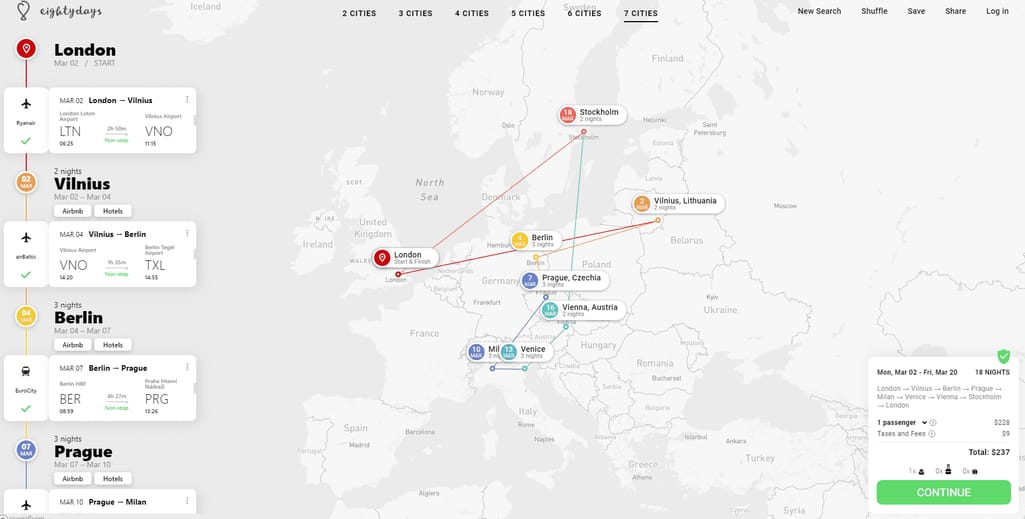
It will take days for a regular traveler to create such a complex itinerary, Eightydays cuts this to minutes
Investigate and define your market and target audience
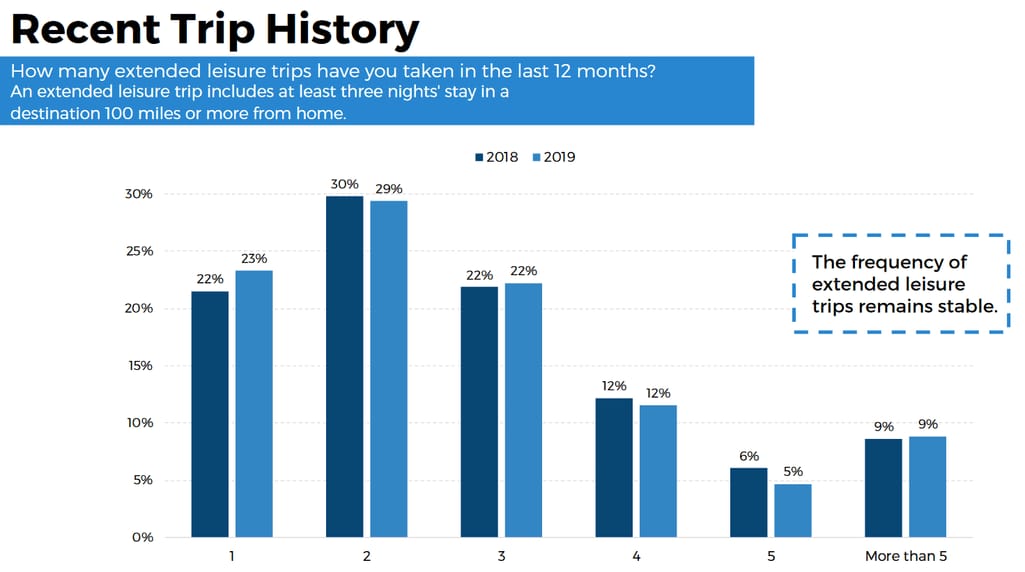
Skift, Experiential Traveler Survey , 2019
Analyze your competitors
Establish your partnerships with service providers, define your pricing strategy, determine the right distribution and promotion channels, metasearch engine.
- You can manually check prices and manually change markups.
- You can use automated dashboards to track your performance and then manually change markups.
- The most advanced scenario is to create an automated commission engine that will keep all your markup rules and will be adjusting your margin on the go, reacting to competitor results.

Prestigia, a small OTA with about 200 thousand monthly visitors, wins on Kayak with this hotel deal as it targets boutique accommodation
Search engine

Orbitz has dedicated landing pages for hundreds of their deals and packs them with all useful information that a traveler may need: a booking widget, selected fares, basic information, and even short copy describing the trip
- Internal activities to meet technical standards of search engines. These usually include installing tools like Google Console and Google Analytics, working with meta tags, reviewing a website for the right page redirection, code errors, and others.
- External activities usually include working with keywords, texts in general, and acquiring backlinks from other websites.

Email marketing

One of the great examples of submitting discounts was Kimpton Hotels and Restaurants. The discounts promoted the unpopular post-Christmas holiday season

As you can see, there are both wallet-friendly and luxurious destinations and tour packages
Web adverts
Video blogging and other social media, final recommendations.
Cyber Monday Deal Up to 60% Off

The Ultimate Guide to Creating a Foolproof Digital Marketing Strategy for Travel Agencies
Table of content
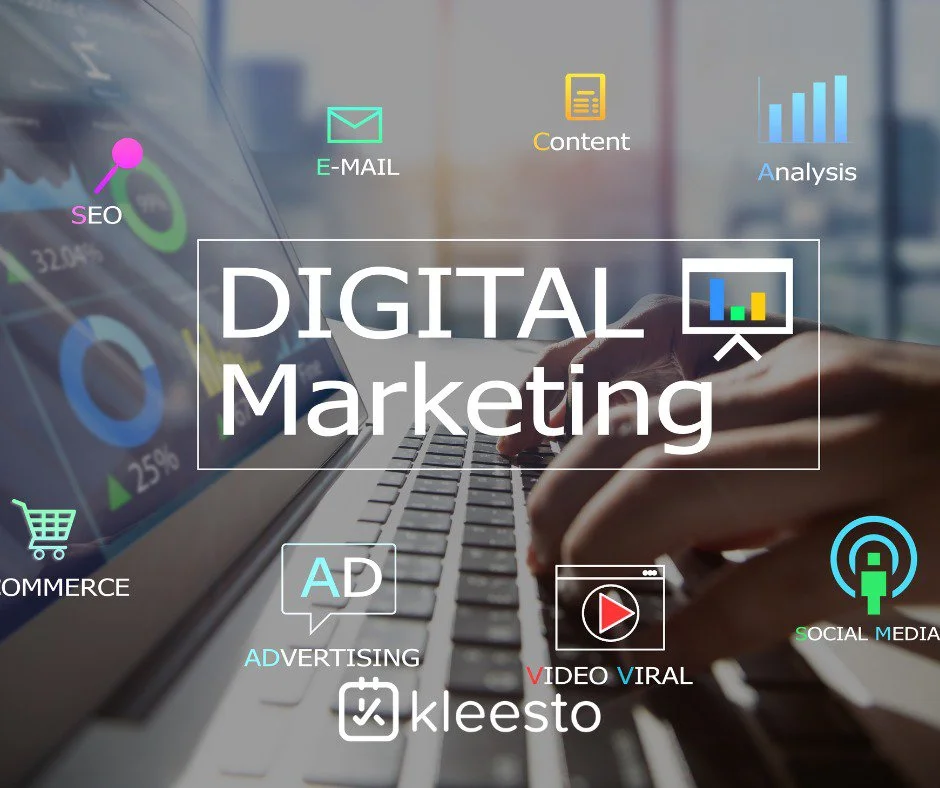
Digital marketing strategy for a travel agency should be a priority. Digital marketing helps them find new people who might want to go on trips. This is super important because nowadays, everyone uses the internet a lot. Plus, a travel agency can show all their incredible online trips.
The Importance of Digital Marketing Strategy for a Travel Agency
Next, digital marketing can help a travel agency stand tall among others. This means they won't be left behind. When they use digital marketing, they can talk to people who might want to go on trips. And guess what? They can also keep in touch with people who have already gone on trips. They can do this by sharing fun and helpful stuff.
A digital marketing strategy for a travel agency is like a magic tool. They can use it to find the exact people interested in their trips. Not only that, but they can also make special offers that are perfect for each person. The best part is that they can see if what they are doing is working or not. This way, they can make more intelligent choices in the future.
Furthermore, travel agencies can chat with their audience through social media, Google, and emails. This helps them to spread the word about their brand. Also, it can boost their sales because people will know about their fabulous trips. Imagine getting a message about a dream vacation! That’s how travel agencies can use digital marketing to connect with people.
Finally, digital marketing lets travel agencies see how well their campaigns are doing. They can see what’s working and what’s not. This means they can make better plans for the future. With all this cool info, they can decide how to make their next campaign even more awesome. It’s like getting secret tips on how to make everything they do even better!
Key Takeaway:

- Digital marketing strategy for a travel agency is crucial: It allows them to reach potential customers online and showcase the agency's unique features, services, and packages.
- A comprehensive digital marketing strategy for tour operators must include content marketing, social media marketing, SEO, email marketing, and mobile optimization. These strategies create an effective online presence and drive the agency's website traffic.
- Social media marketing is vital for travel agencies: It allows them to engage with customers, build brand awareness, and increase loyalty. Travel businesses should focus on creating compelling visual content and sharing helpful information about travel destinations, deals, and packages.
Digital Marketing Strategies for Travel Agencies
Digital marketing is like a giant puzzle. No single piece fits everyone, especially for travel agencies. As someone who helps people plan trips, I know digital marketing is crucial. But hold on! It can sometimes feel like too much to handle. I've made it simple and split it into content and social media marketing.
In content marketing, you get to share cool stuff online. It’s like telling stories about the fantastic trips your agency offers. You can share pictures, write about adventures, and give tips. This helps people know more about the excellent places they can visit. Trust me; it's like showing them a treasure map for fun!
Now, let’s talk about social media marketing. This is where you can chat with people. You can use places like Facebook, Instagram, and Twitter. It's like a big online party where you can tell everyone about your travel agency . Sharing fun posts and pictures will make people want to join in on the adventures. This way, you'll become a travel superhero, helping people find the perfect trips!
Content Marketing
Creating fun and helpful content is like making a treasure chest for travelers. You can put videos and blog posts on your website. These are not just posts – they’re packed with great information travelers will love. When people see your content is quality, they’ll trust you more. They might even share your website with friends, bringing in more visitors!
But wait, there’s more. You can add quizzes, cool pictures with facts, or even live events to make your website extra fun. Imagine being on a quiz show all about travel! Also, keep adding new stuff to your website. Search engines like Google love websites that are always fresh and exciting. Oh, and don’t forget to add info in different languages and helpful tips like where to eat.
Lastly, sprinkle magic words (or keywords) all over your website. This makes it easy for travelers to find you. Also, keep an eye on how your website is doing. You can use special tools to see what people like the most. This way, you’ll know how to make your website even better. Now, with these tips, you’re all set to make your travel agency ’s website the most relaxed spot for travel lovers!
Social Media Marketing
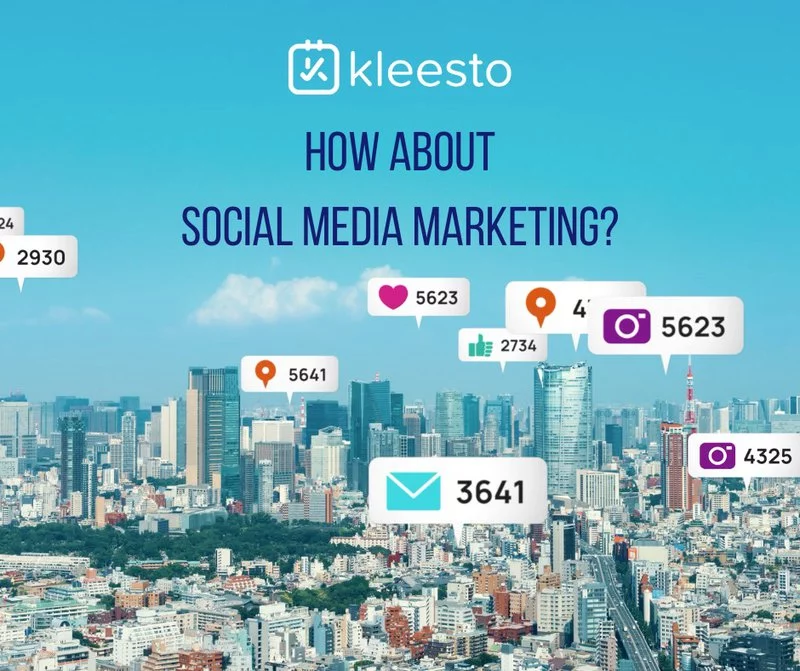
Using social media is like throwing a big, fun party for travelers. Travel agencies can use sites like Facebook, Instagram, and Twitter to chat with people who love to travel. They can become super popular online by sharing cool ads and fun posts. This helps bring in more travelers.
Here’s a super tip: be like clockwork with your posts. This means picking a schedule and constantly posting on those days. Maybe every Monday and Thursday? Or how about Tuesdays and Fridays? Whatever you pick, stick to it. This keeps your followers excited and waiting for your next post, just like waiting for the next episode of their favorite show.
So, if you're a travel agency , get your party hats on and start posting on social media! Share beautiful pictures and incredible deals, and chat with your followers. Remember, the key is to be consistent and keep the party going. This way, you’ll be the talk of the town among travelers!
Search Engine Optimization
Imagine your travel agency is a hidden treasure. SEO is like the map that helps travelers find this treasure online. It ensures that people find your travel agency at the top of the list when they look for trips. SEO does this by adding particular words to your website and ensuring it’s easy to use. This way, more people will visit your website without you having to do extra work.
But wait, there’s more! You can also use SEO to help people in your area find your travel agency . This is called local search optimization. You can also create links to other cool websites and connect your site to social media. This is like telling your friends to tell their friends about the treasure. All these tricks make your SEO even better!
Here's a pro tip: SEO is like a game that keeps changing. So, you have to watch it and change your strategies now and then. This way, your treasure map stays up-to-date, and more travelers can find your excellent travel agency . So, get ready to be the most popular travel agency in town with SEO!
Email Marketing
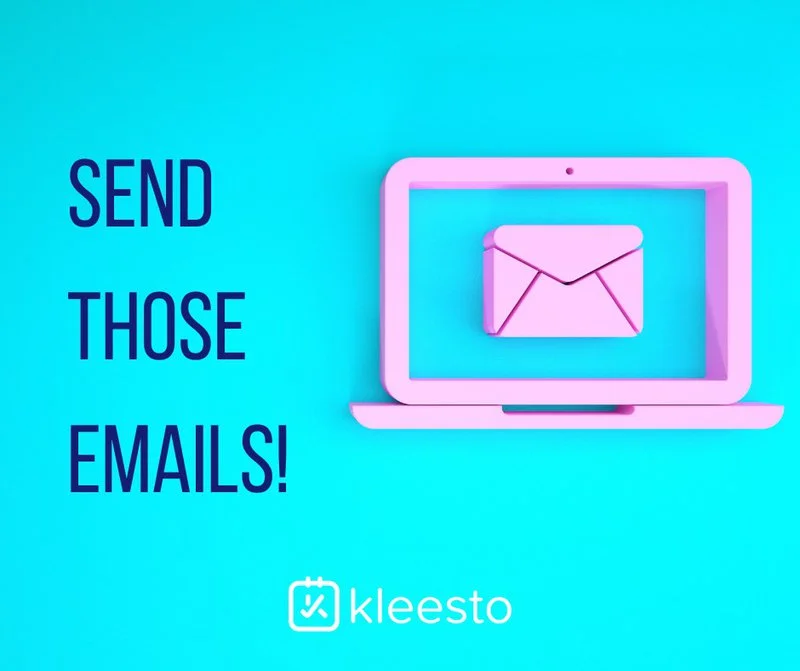
Picture email campaigns as little postcards you send to travelers. But these are not just postcards. These are special because they talk about what each traveler loves. You can even put a magic button in these emails that take them to your website! How cool is that? This button is like a treasure hunt clue, getting travelers excited to see what’s next.
Now, let's get a bit fancy. You can try A/B testing. It’s like sending two different postcards to see which one travelers like more. You can try different pictures, words, or titles. This way, you'll know which postcard gets more travelers excited. Also, you can set up magic postcards that send themselves! Like a welcome postcard when someone new joins or a reminder if they forget something in their cart.
Adding a personal touch to your postcards is like a sprinkle of magic. It makes travelers feel special. Imagine getting a postcard that talks about your dream vacation! You can keep updating these postcards as you learn more about each traveler. An excellent pro tip: link your postcards to social media. This way, travelers can share them with friends, and your travel agency will become famous!
So, get your creative hat on and send these unique email postcards to travelers worldwide!
Mobile Optimization
Think of your travel agency 's website as a fabulous clubhouse. Imagine your clubhouse can fit into everyone's pocket through their phones! That's what mobile optimization is all about. It's like making a mini clubhouse that looks great and is easy to use on smartphones. Your mini clubhouse should fit on different phone screens and not take forever to open.
Here’s how you make an excellent mini clubhouse. Keep things simple and tidy, like a well-organized playroom. Make sure buttons are big enough to tap with fingers, and add magic buttons that let people call or email with just a tap. Oh, and don’t forget to add ways to share on social media!
Adding some special touches can make your mini clubhouse even more relaxed. Make pictures load super-fast, and use videos that don’t take up too much space. Pick fonts that are easy to read on phones. Also, check how fast your clubhouse opens with tools like Google's PageSpeed Insights. It's like a speedometer for your website!
Creating a Travel Website that Converts
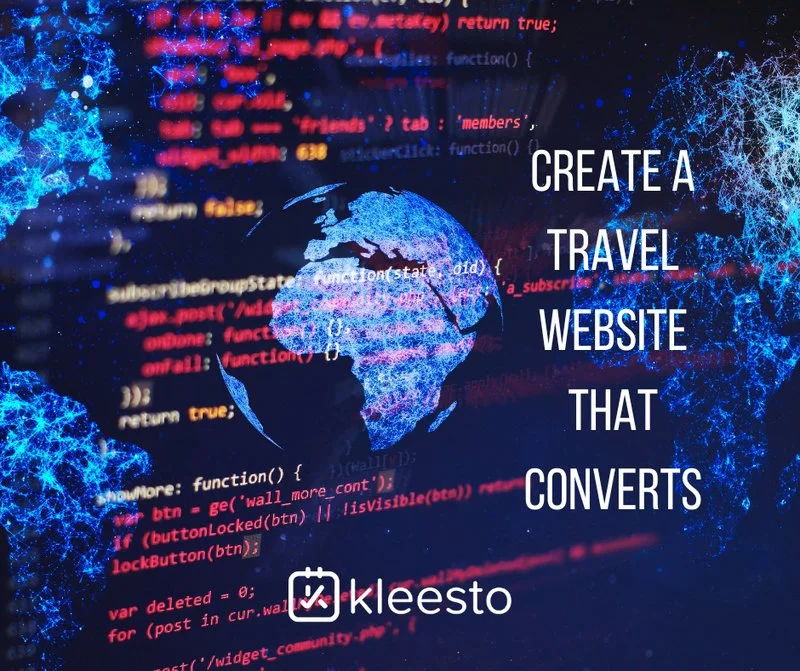
Imagine making a travel website like building an incredible treehouse. First, you need to make sure your treehouse looks fantastic. Add colorful images and exciting videos of unique places. This gets everyone wanting to be part of the adventure!
Next, make it easy for your friends to navigate the treehouse. Clear signs and easy paths are a must. Add magic buttons that do cool stuff, like showing more pictures or booking a trip. Also, have a wall where friends can write about how much fun they had on their adventures. This makes others want to join in too!
Now, don’t forget to make your treehouse speedy. Nobody likes waiting! Keep trying new things to see what makes your treehouse the best. This is called A/B testing. It’s like choosing between a slide or a rope ladder to see which is more fun.
So, get your building hat on and start making your travel treehouse. With great pictures, accessible paths, magic buttons, and fun notes from friends, your treehouse will be the talk of the neighborhood! Take a look at our blog post about how to create a travel website that converts.
Implementing a Comprehensive Digital Marketing Strategy for Travel Agencies
Imagine you're a travel agency captain setting sail in the vast ocean of the internet. To have a great adventure, you need a treasure map – that’s your digital marketing strategy! First, figure out which travelers you want on board. Also, spy on other ships (your competitors) to see what cool stuff they’re doing.
Get your spyglass and spot the best tools and islands (platforms) where travelers hang out. This will make your ship (brand) famous and attract many travelers!
Make sure your ship looks fantastic and is full of treasure. Create extraordinary stories, make your ship speedy, and throw parties on social media where you can chat with travelers.
But beware, the ocean keeps changing! Keep a lookout for new islands and sea creatures (trends). You have to keep adjusting your treasure map to keep up.
Remember, being a travel agency captain is an ongoing adventure. Keep your ship shiny and treasure map updated, and always be ready to set sail to new places!
Some Facts About The Ultimate Guide to Creating a Foolproof Digital Marketing Strategy for Your Travel Agency :
- Digital marketing is becoming increasingly important for travel and tourism agencies as more and more people use the internet to research and book their trips.
- Travel and tourism companies must be more strategic in their digital marketing efforts to stand out and attract customers.
- Content and social media marketing are effective digital marketing strategies for travel and tourism companies to attract potential customers and build brand awareness.
FAQs about The Ultimate Guide To Creating A Foolproof Digital Marketing Strategy For Your Travel Agency

What is the importance of digital marketing in the travel and tourism industry?
Think of digital marketing as a magic megaphone for travel agencies. It lets them shout out to all the adventurers out there! So many travelers are looking for fun and tons of online travel clubs called OTAs. Plus, many travel clubs are trying to be the coolest in a place as big as the US. That’s why travel agencies need a magic megaphone to be heard!
Travelers these days are like kings and queens. They want special treats just for them. Imagine if you could tell each traveler about a trip made just for them. “Hey, Sally! Want to see the tallest mountains?” or “Hello, Mike! Ready for the best ice cream tour?”. This would make them super happy!
Digital marketing is that magical tool. It helps travel agencies talk to travelers uniquely through computers and phones. This way, travelers hear about trips that make them jump with joy!
So, travel agencies, grab your magic megaphones and call all the fantastic adventurers! Let's make travel dreams come true!
How can content marketing help travel agencies attract potential customers?
Content marketing can be a great way for travel agencies to attract potential customers by creating informative and engaging content highlighting popular travel destinations or helpful tips for travelers. For example, creating blog posts or producing videos that showcase the beauty and excitement of traveling can capture the attention of potential travelers and build brand awareness for the travel agency .
What is the importance of customer reviews and ratings in travel and tourism?
Think of customer reviews and ratings like gold stars for travel agencies. When someone plans a trip, they want it to be perfect. So, they look at what other travelers have to say online. It’s like asking a friend, “Hey, did you like that hotel?”
Now, imagine a travel agency that gets many gold stars and happy words from travelers. Others see this and think, “Wow! This travel agency must be excellent!”. These gold stars and happy words are called positive customer reviews and high ratings.
Lastly, these gold stars help travel agencies become famous well. People will think of them as the superstars of travel. And guess what? More people will want to plan their trips with them. So, travel agencies, let's collect those gold stars and happy words!
How can email marketing benefit a travel agency ?
Email marketing is like sending unique invitations to a party! For travel agencies, it’s an intelligent way to talk to people who might want to go on trips. The first kind of invitation is the "Super Saver" invite. This one has deals and packages that make trips cost less.
The second kind of invitation is called the "Wise Traveler." It’s like a friendly letter that shares clever tips and advice. It might say, "Pack a small umbrella, just in case!" or "Try the ice cream in Italy!"
Lastly, there’s the "Adventure News" invite. This one is like a mini-newspaper that tells people about cool things happening worldwide. It could say to them about a festival in Brazil or a new museum in France.
So, all these unique invitations in the email make people super excited. They think, “This travel agency knows all the cool stuff!” And the next time they want to go on a trip, they will think of that travel agency . So, travel agencies, get your fancy invitations ready, and let’s start the email party!
What is influencer marketing, and how can it help travel agencies?
Imagine if a famous explorer tells everyone how excellent a travel agency is. That's what influencer marketing is like! Travel agencies team up with cool people called influencers. These influencers are like modern-day explorers with lots of friends on social media.
First, these influencers go on fantastic trips. They might climb mountains, try new foods, or visit ancient ruins. All the while, they’re taking pictures and telling stories.
Next, they share their adventures with all their friends on social media. They might post a picture of a beautiful beach and say, “Thanks to this amazing travel agency , I’m having the time of my life!”. They can also write blogs like digital diaries, telling everyone about their journey.
Ultimately, those who follow these influencers think, “I want to have fun like them!”. They get to know the travel agency through someone they think is cool. So, influencer marketing is like having a famous explorer tell the world how excellent a travel agency is. Travel agencies, it’s time to team up and go on an adventure!
So, are you ready to make your dreams come true with your magic map and the kleesto Pandas? Tie your shoes, pack your backpack, and let's get started on this exciting journey!
- booking software
- social media to promote tours
Share it on
For direct inquiries that need personalized assistance.

Join us for a 21-Day exploration of kleesto
Don’t worry, Kleesto is here to help. Start a free Trial Demo.
Don't just leave empty handed!
Download our Ultimate Business Guide to boost your digital presence
Learn how to Get More Bookings , Save Time and Increase your Booking Revenue!
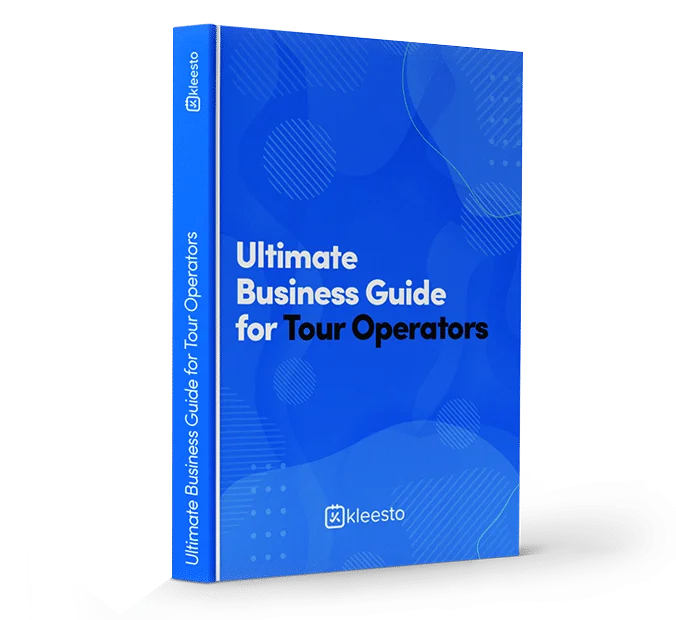
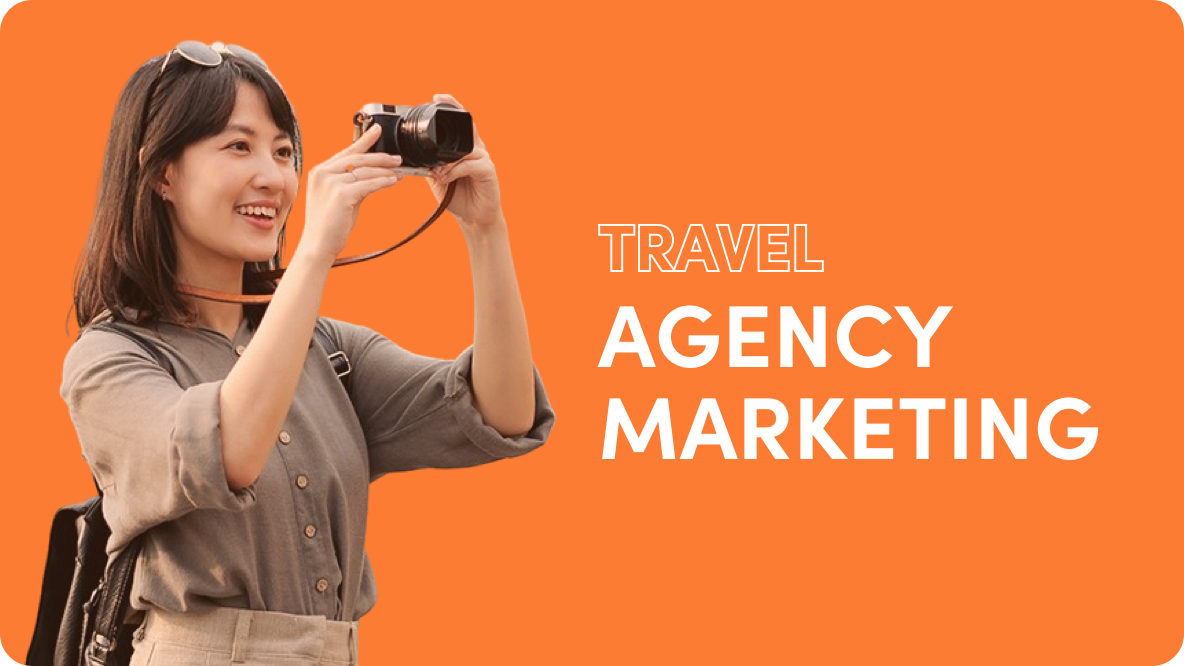
Creating Your Travel Agency’s Digital Marketing Plan: 8 Best Practices

Laura Kloot
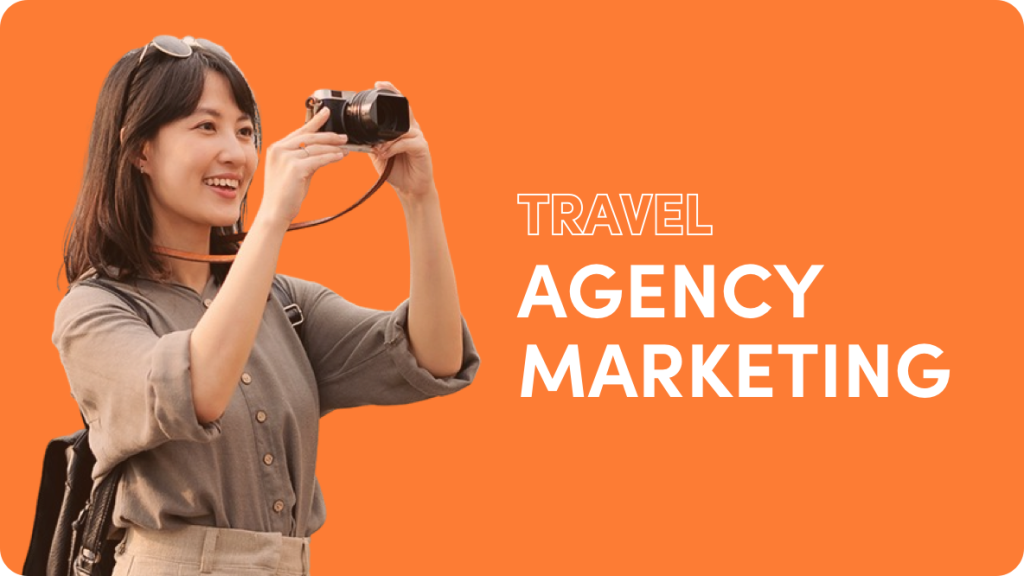
In the ever-evolving digital landscape, travel agencies face increasing competition in attracting online bookings and building customer relationships. An effective travel agency marketing plan tailored to your niche and target market is essential for maximizing your ROI. This article provides 8 updated tips and best practices for creating a successful marketing plan that resonates with customers and drives growth in the travel industry. Let’s go!
Personalize Your Website, Content, and Services
To stand out in the crowded travel market, personalization is key. Create a unique identity and image for your agency by offering personalized or niche services, interactive customer experiences, and customized recommendations based on individual preferences. Tailor your website design, content, and offerings to provide a personalized touch that resonates with your target audience.
Focus on High-Quality Content
Compelling content is the foundation of a successful travel agency website. Create informative, engaging, and visually appealing content that captivates your audience and drives traffic to your site. Incorporate storytelling, share personal travel experiences, provide destination guides, and offer insider tips. Invest in professional copywriting or try out generative AI writing tools to produce a regular stream of high-quality content that boosts site visits and encourages customer engagement.
Leverage User Reviews and Testimonials
Online reviews and testimonials are powerful tools for building trust and enhancing your agency’s reputation. Encourage satisfied customers to leave reviews on platforms like Google My Business, TripAdvisor, Yelp, and industry-specific review sites. Respond promptly to both positive and negative reviews, demonstrating your commitment to customer satisfaction and actively addressing concerns.
Optimize Your Website for User Experience
A visually appealing, user-friendly website is essential for converting visitors into customers. It is also essential for good SEO rankings . Ensure your website is responsive, optimized for mobile devices, and offers seamless navigation. Utilize intuitive booking interfaces, high-quality visuals, and captivating headlines to engage visitors and drive conversions. Incorporate customer reviews and testimonials into your website to showcase social proof and build trust.
Boost Your Social Media Presence
Focus on the platforms where your target audience spends their time, whether it be Facebook, Instagram, TikTok, Twitter, LinkedIn, or a combination of these. Stay updated with emerging platforms such as BeReal, Telegram, and Clubhouse. Leverage social media to connect with a broader audience, share engaging content, promote special offers, and interact with customers in real time. Influencer collaborations can also amplify your agency’s reach and credibility.
Focus on Mobile Marketing
As mobile usage continues to rise, optimizing your marketing efforts for mobile devices is critical. Develop a mobile-responsive website or create a dedicated mobile app for your travel agency. Mobile apps offer personalized experiences, loyalty programs, and push notifications, enhancing customer engagement and convenience. Prioritize mobile advertising, mobile-friendly emails, and mobile-specific promotions to reach and engage your mobile-savvy audience.
Harness the Power of Visuals
Visual content plays a crucial role in captivating and inspiring potential travelers. Utilize high-quality images, videos, and immersive virtual tours to showcase destinations, hotels, and experiences. Incorporate user-generated content by encouraging travelers to share their photos and videos, further enhancing your agency’s authenticity and social proof.
Set Goals, Track Metrics, and Adapt
Establish measurable goals for your marketing plan and regularly monitor KPIs to track progress. Analyze website analytics, social media engagement, conversion rates , and customer feedback to gain insights into what resonates with your audience. Use data-driven decision-making to adapt your marketing strategies, focusing on successful channels, content formats, and customer preferences.
With the rapid changes in online marketing, travel agencies must adapt their strategies to remain competitive. Stay agile, experiment with new trends, and continuously refine your strategies to attract, engage, and convert customers in the crowded and challenging travel industry.
Launch your Campaign!
Create full funnel campaigns that drive real business results..

Related Articles

Camilla Salemme

Heather Riley
For Advertisers
- Advertise with Outbrain
- Native Advertising
- Contextual Advertising
- Demo Outbrain
- How to Buy Outbrain
- Outbrain Academy
- Advertiser Guidelines
- Advertising FAQ
- Advertising Glossary
- Vertical Insights
- Vertical Hub
- Affiliate Marketing
- Affiliate Hub
- High-Conversion Content
- Repurpose Social Campaigns
About Outbrain
- Company Overview
- Cultural Manifesto
- Trust & Transparency
- For Publishers
- Thought Leadership
- Outbrain Blog
- Resources Hub
- Case Studies
- Performance Marketing
- Advertising Academy
- Publisher's Directory
- Help Center
Ready to start?
Try Outbrain for Advertisers today
- Interest-Based Ads (Opt Out)
- Privacy Policy
- Terms of Use

Travel Marketing: Strategies That Work
In the travel industry, the success of one’s business is greatly influenced by the effectiveness and creativity of their marketing strategies. At its core, travel marketing is the linchpin, connecting destinations with dreams, services with experiences, and accommodations with adventures.
It’s the art and science of inspiring potential travelers, guiding them from initial curiosity to the final act of booking. The importance of travel marketing cannot be overstated; it is the driving force that propels travel companies, agencies, and destinations into the spotlight of their target audience.
As we delve deeper, emerging technologies like virtual reality, mobile apps, and augmented reality continually reshape the tourism industry’s landscape, making marketing efforts more interactive and immersive.
These tools and traditional digital marketing , such as email marketing, social media, and SEO, form the backbone of an effective marketing strategy. They allow travel brands to weave compelling narratives around travel destinations, showcasing unique selling points through engaging content, virtual tours, and real-world settings.
Effective marketing strategies—crafting engaging social media posts, leveraging user-generated content, or executing targeted email campaigns—cannot be underestimated in driving the success of travel companies and destinations. These strategies ensure that every marketing effort is a step towards enhancing the customer experience, engaging potential travelers, and building a loyal customer base.

Online travel agencies and tour operators vie for attention on various platforms, the need for standout travel marketing tips and strategies has never been more critical. The best travel marketing tips hinge on understanding the specific demographic of your target market, engaging with them through high-quality content on platforms they frequent, and utilizing data analytics tools like Google Analytics to refine your approach.
For travel agencies, travel agents, and all stakeholders within the travel business, embarking on refining or reinventing your travel marketing strategy means embracing many digital tools—from SEO to influencer marketing and virtual reality tours to social media marketing campaigns. These tools aim to attract visitors to a particular destination and enhance the overall marketing campaign cost-effectively and efficiently, ensuring that marketing content resonates well with prospective customers.
Table of Contents
The Essence of Travel Marketing: Creating Dreams into Destinations

Travel marketing stands at the intersection of aspiration and action. It embodies the essence of inviting potential travelers to leave their comfort zones and explore the vast, vibrant world beyond. It is an intricate blend, where strategy and creativity converge to capture the imagination of prospective customers and inspire them to embark on journeys anew.
At its heart, travel marketing seeks to communicate the unparalleled joy and enrichment that comes from discovering new travel destinations, experiencing diverse cultures, and making memories that last a lifetime.
The core objectives of travel marketing are to raise awareness, spark interest, and ultimately drive bookings for travel services offered by travel agencies, online travel agencies, tour operators, and travel companies.
Through a meticulously crafted mix of digital marketing tactics—including social media marketing, email marketing, content marketing, and search engine optimization—travel marketers strive to reach their audience online, from social media platforms to review platforms and beyond.
But travel marketing goes beyond mere promotion; it is about weaving stories that resonate, leveraging user-generated content and virtual tours to bring real-world settings to vivid life. With VR and AR, potential travelers can get tantalizing previews of what awaits them, leaping from dreaming to booking faster than ever.

This technological evolution, coupled with traditional yet powerful techniques like engaging email campaigns and informative blog posts, creates a multifaceted approach capable of reaching customers on mobile devices and desktops alike.
The primary purpose of tourism marketing is to inspire, persuade, and invite travelers to explore specific destinations, experiences, or services. It’s about highlighting a destination’s unique selling points and showcasing the beauty and thrill of travel destinations through engaging content and spectacular imagery. Travel marketing strategies aim to make the idea of travel irresistible, turning potential travelers’ wanderlust into concrete travel plans.
Practical travel marketing efforts rely heavily on understanding the specific demographic of the target market. It involves comprehensive market research to tailor marketing strategies that resonate with the target audiences’ interests, preferences, and behaviors.
The best travel marketing tips always emphasize the importance of aligning marketing content with the values and desires of prospective customers, ensuring that every social media post, marketing campaign, and piece of marketing content is designed to attract visitors and convert interest into action.
In a highly competitive tourism industry, standing out requires following the latest travel marketing strategies and setting the trends. From leveraging the power of influencer marketing to enhance customer engagement and crafting memorable marketing campaigns that utilize the cost-effectiveness of digital marketing to providing valuable information through high-quality content and answering queries with precision—every aspect of travel marketing is about enhancing the customer experience and building a robust customer base.
Travel agencies and travel businesses are thus challenged to adopt a marketing strategy that captures the essence of their brand and the destinations they promote and speaks directly to the hearts and minds of potential travelers. This involves utilizing traditional and innovative marketing channels, from social media to virtual reality, to create immersive experiences that make travelers feel as though they’ve already begun their journey, even before booking their trip.
As we navigate the travel industry, the role of travel marketing becomes increasingly significant. It’s about offering discounts that matter, using mobile apps to ease the journey, deploying ad campaigns that capture attention, and ultimately, ensuring that your travel brand becomes synonymous with adventure, relaxation, and everything in between.
For travel marketers, embracing the latest travel marketing strategies and tips means continuously experimenting, adapting, and exceeding the expectations of today’s discerning traveler.
In the quest to attract visitors and convert them into loyal patrons, travel marketing is a journey that requires passion, innovation, and a deep understanding of the tourism industry’s dynamics. It is a journey of connecting with potential travelers personally, making every marketing effort count in the quest to turn travel dreams into tangible realities.
Key Strategies for Effective Travel Marketing

In the travel industry, distinguishing your travel brand requires not just a presence but a profoundly impactful one. Here, we delve into the crux of strategies that empower travel companies to navigate and lead in the competitive arena of tourism marketing.
Understanding Your Audience
Understanding your customers is essential for a successful travel marketing strategy. This entails conducting market research to grasp prospective customers’ preferences, behaviors, and motivations. Travel agencies and marketers must tailor their marketing messages to meet their target market’s needs and desires, whether catering to luxury travelers, adventure seekers, or business trip clients.
Identifying and segmenting your target audience ensures that your marketing efforts resonate on a personal level, significantly increasing the likelihood of converting interest into bookings.
Leveraging Digital Platforms
Effectively utilizing digital platforms is indispensable for travel marketers. Social media, content, and email marketing are key channels for reaching potential travelers, offering a direct line to your audience where they spend considerable time: on their mobile devices.
The role of SEO and search engine marketing (SEM) extends beyond mere visibility; it’s about ensuring that when prospective customers search for travel destinations or services, your brand appears front and center on search engines. This digital approach broadens your reach, enhances customer engagement, and drives more traffic to you online.
The Power of Storytelling
Storytelling transcends traditional marketing by creating an emotional and personal connection. For travel businesses, leveraging real stories and experiences can significantly enhance their brand’s appeal. Through engaging content, virtual tours, and immersive real-world settings, storytelling can transport potential travelers into the narrative, making the brand’s experience irresistible.
This approach builds a deeper connection with your audience, turning abstract services into tangible desires.
Influencer and Affiliate Marketing
Where social proof reigns supreme, collaborating with influencers and engaging in affiliate marketing present unparalleled opportunities for travel brands to expand their reach. Influencers can tap into new audiences, lending their credibility and audience to your brand. Affiliate marketing, on the other hand, leverages partnerships to promote travel services, offering a performance-based approach that can significantly increase bookings.
Both strategies are vital in a comprehensive travel marketing plan, offering cost-effective ways to attract visitors and enhance the travel customer experience.
Data-Driven Marketing
The pivot towards data-driven marketing strategies marks a turning point in how travel agencies and companies approach their marketing efforts. Data analytics allows marketers to understand customer behavior, refine marketing strategies, and precisely measure the return on investment (ROI).
This analytical approach enables travel businesses to adjust their strategy based on performance data, ensuring that every marketing campaign is optimized for maximum impact and cost-effectiveness.
Implementing these key strategies in your travel marketing efforts can dramatically transform how your travel agency or company connects with potential travelers. From the strategic utilization of digital platforms and SEO to the compelling power of storytelling and the targeted approach of influencer marketing, each element plays an important role in attracting your audience.
Moreover, grounding your marketing strategies in data ensures that your efforts are creative but also smart, adaptable, and results-driven. In the competitive landscape of the tourism industry, where every travel brand vies for attention, these strategies are not just recommendations—they are the cornerstones of success in travel marketing.
Navigating the Trends in the Travel Industry

In the travel industry, staying abreast of current trends is not just beneficial—it’s imperative for survival and growth. Travel marketing is changing, shaped by technological advancements, changing consumer preferences, and the global economic climate.
Travel agencies, tour operators, and travel companies must adapt and innovate, ensuring their marketing strategies are as fluid and flexible as the trends they follow.
Embracing Digital Transformation
The digital transformation within the tourism industry has accelerated, with virtual reality (VR) tours, augmented reality (AR) experiences, and mobile apps becoming increasingly integral to travel marketing strategies. These technologies offer potential travelers immersive previews of destinations, enhancing the customer experience before their journey begins.
Travel brands leveraging these tools in their marketing campaigns find themselves at the forefront, captivating their target audience’s imagination and converting interest into bookings more effectively.
UGC and Influencer Marketing
User-generated content (UGC) and influencer marketing have emerged as powerful tools in the travel marketer’s arsenal. Encouraging customers to share their real-world experiences on social media and review platforms provides valuable information to prospective customers and builds trust and credibility for your brand.
Collaborating with influencers, on the other hand, can amplify your reach and attract visitors from new demographics and markets.
These strategies, rooted in authenticity, can significantly enhance engagement and foster a sense of community around your travel brand.
Personalization and Customer Engagement
Personalization is key to capturing the attention of potential travelers. Customized email marketing campaigns , push notifications, and landing pages that cater to your target market’s specific interests and preferences can dramatically improve customer engagement.
Travel businesses can boost marketing effectiveness by crafting personalized messages with data analytics and market research to understand their customer base.
Sustainable and Responsible Travel
As environmental concerns take center stage globally, sustainable and responsible travel has become a compelling, unique selling point for many travel destinations and services.
Travel companies that highlight their commitment to sustainability in their marketing content align with the values of a significant segment of their target audience and contribute to a larger movement towards eco-friendly travel.
This approach enriches the customer experience and positions your brand as a responsible leader in the tourism industry.
Leveraging SEO and Other Search Engines
With most customers beginning their travel planning journey online, the importance of SEO and visibility on other search engines cannot be overstated. A well-thought-out SEO strategy ensures that your travel services appear prominently when potential travelers search for related keywords.
This, combined with engaging content and high-quality visuals online, can significantly increase traffic and conversion rates.
Adaptation and Innovation
To stay ahead in the travel industry, businesses must constantly adapt their marketing strategies . This means keeping an eye on the latest travel marketing strategies, understanding the evolving preferences of your target audience, and being ready to pivot your approach based on performance data and industry trends. Whether exploring new digital marketing avenues, adopting the latest VR technology, or refining your social media strategy, the willingness to innovate can set your travel brand apart.
Navigating the trends in the travel industry requires a proactive and dynamic approach to travel marketing. Travel marketers can ensure their brand survives and thrives by embracing digital transformation, leveraging user-generated content, personalizing customer engagement, promoting sustainable travel, and optimizing search engines.
Conclusion: Charting the Course for Success in Travel Marketing

As we draw the curtain on this exploration of effective travel marketing strategies, it’s clear that the path to success in the travel industry is dynamic and multifaceted. The landscape of travel marketing is constantly evolving, shaped by new technologies, changing consumer behaviors, and the global push towards more sustainable practices.
For travel agencies and travel companies, staying ahead means embracing innovation, understanding the needs and desires of your audience, and continuously refining your strategies to align with the latest trends.
The key takeaways from our journey through the essentials of travel marketing underscore the importance of leveraging digital platforms, engaging in storytelling, utilizing influencer and affiliate marketing, and adopting a data-driven approach to understand and connect with potential travelers. By implementing these strategies, travel marketers can enhance the customer experience, attract visitors to various travel destinations, and drive bookings and growth for their businesses.
Virtual reality, augmented reality, and mobile apps offer an unparalleled opportunity to bring destinations to life, offering virtual tours and engaging content that captivates prospective customers’ imaginations. Moreover, the power of user-generated content and influencer marketing in building trust and credibility cannot be overstated. These elements, combined with targeted email marketing campaigns and a robust social media strategy , are vital in creating a compelling digital presence that speaks directly to the heart of your target.
Yet, the foundation of all these efforts lies in understanding your audience. Market research, search engine optimization, and leveraging data analytics provide invaluable insights into the preferences and behaviors of potential travelers, allowing for the creation of personalized and effective marketing campaigns.
Adopting the latest travel marketing strategies and tips in an industry as competitive as tourism is not just a recommendation—it’s a necessity. From enhancing your social media posts to optimizing your website for mobile devices and other search engines, every aspect of your marketing plan should aim to provide valuable information, answer queries, and offer discounts that resonate with your specific demographic.
Let this exploration of travel marketing strategies serve as a beacon, guiding your marketing efforts toward innovation and success. The potential for growth and achievement in travel marketing is boundless for those willing to change, try new ideas, and adapt to the travel industry. Remember, the essence of travel marketing is not just to sell a service but to inspire dreams, cultivate experiences, and enrich lives.
FAQ: Navigating the World of Travel Marketing
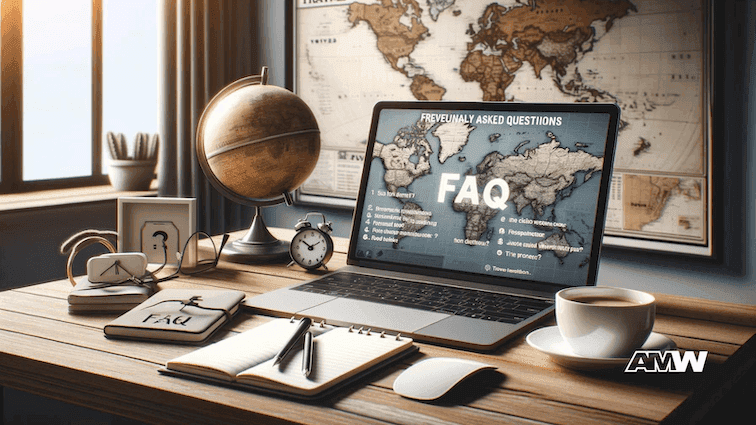
In the travel industry, questions abound regarding how to effectively market travel services and destinations. Here, we delve into some of the most pressing queries, offering insights and strategies to help travel agencies, tour operators, and companies navigate the complex world of travel marketing.
What is the best marketing strategy for a travel agency?
Understanding your audience is the cornerstone of any successful travel marketing strategy. The best strategy involves tailoring your approach to meet your audience’s interests, needs, and desires and effectively leveraging digital platforms. Incorporating a mix of social media marketing, SEO, content marketing, and email campaigns will ensure that your travel agency reaches a wider audience and engages potential travelers in meaningful ways.
How do I advertise my travel agency online?
Using digital marketing tools and platforms to advertise your travel agency online effectively. Use social media to create engaging posts and share high-quality content showcasing your unique selling points and travel destinations. Use SEO strategies to improve your visibility, making it easier for customers to find you. Content marketing can provide potential travelers with valuable information and immersive experiences through blogs and virtual tours. Additionally, email marketing campaigns allow for personalized communication, offering discounts and updates directly to your target market.
What is an excellent online marketing strategy?
A good online marketing strategy is comprehensive and multifaceted, incorporating SEO, content marketing, social media engagement, and data analytics to drive decisions. It focuses on creating high-quality content that resonates with your audience, using social media to foster customer engagement, and analyzing data to refine and optimize marketing efforts. A successful strategy also adapts to the latest travel marketing strategies and technologies, such as virtual reality and mobile apps, to enhance the customer experience and ensure your marketing content stands out in a competitive landscape.
What is the meaning of travel marketing?
Travel marketing is the dynamic process of promoting destinations , services, or experiences to potential travelers. Its primary aim is to inspire and persuade individuals to embark on journeys for leisure, business trips, or cultural exploration. Through various marketing channels and strategies, travel marketing seeks to connect with prospective customers, highlight the unique attractions of travel destinations, and, ultimately, drive bookings and travel activity.
What is the primary purpose of tourism marketing?
Tourism marketing aims to attract visitors to a destination by highlighting its unique attractions, culture, and experiences. It involves crafting compelling reasons for travelers to choose a particular destination over others through engaging content, captivating visuals, and targeted marketing campaigns. Tourism marketing aims to enhance the visibility of travel destinations , improve customer engagement, and contribute to the overall growth of the tourism industry.
How do you market a destination?
Marketing a destination requires a strategic approach that showcases its unique attractions, culture, and experiences. This involves researching your audience’s preferences and using marketing channels to tailor your messaging. Engaging content, including virtual tours, high-quality images, and user-generated content, can bring the destination to life for potential travelers. Influencer marketing can also be crucial in attracting new audiences by leveraging the reach of influencers who align with your brand’s values and demographic.
Adopting these strategies and tips can help travel agencies and companies navigate the complexities of travel marketing and achieve their marketing goals. By focusing on understanding your target audience, leveraging the latest digital marketing techniques, and continuously innovating your approach, the potential for success and growth in the travel industry is boundless.


Travel Agency Marketing (11 Proven strategies & Tips)
Travel Agency marketing is something that I’m passionate about, and I’m pretty good at it too. It’s also how I really started in marketing in 2009, working on my mom’s niche travel agencies.
In this guide, I’m going to explain some tactics I use. I hope you can implement some of the ideas below.
Have a Unique Selling Proposition (USP)
- Find what works
Links and PR
Social media, social advertising.
- Set up a website
- List yourself in all the local directories
Customer Relationship Software
Word of mouth, search engine marketing.
It wasn’t easy to start; I had to learn quite a lot and didn’t have someone to really help me, and the internet was very different back then. But I practised, learned, and tested. I grew to love it. It’s kinda why Travel Tractions Marketing was born 🙂
This guide details how I helped my mom to market her sites 10 years ago and what I do to market my own and client sites today.
My mom had one main business called Webtours, and then she decided to make niche websites for each service offering.
I thought this very silly at the time, but little did I know this was one of the smartest things we did.

It enabled me to learn much quicker than normal (because she had 3+ sites – I could test, try and dabble).
Not only did it allow me to test, but the agency position was also so niche; it gave access to different markets and appeared as a “specialist”.
Becoming or positioning herself as the “specialist” was a no-brainer and her niche agencies grew so much faster (in traffic and clients) than the general brand.
In this article, you will get:
- The best way to stand out
- Travel marketing ideas
- A travel marketing plan
- Travel agency ad examples
And leave a marketing ninja, not really. But you will be wiser. 😉
Marketing for Travel Agents Tips

Know where you differentiate and sell that. This could be customer service, affordability, quality, or speed. Anything that sets you even more apart.
I know it seems like laser focus, but sometimes that’s key. Especially with data-based digital marketing today. If you can zero down on your perfect customer, your cost of Return On Marketing Investment is much lower.
Find What Works
Different things worked for different businesses. Bridal conferences worked well for honeymooners while ranking for school holiday specials worked for the beach holiday agency website. Ranking for “all-inclusive ski holidays” worked great for selling Club Med ski holidays.
When you find out what channel, gap or method of marketing works for you, double down on it! But don’t give up on the other channels – consistency is key.
When she first started her business, it was general travel, but when she specialised, things really took off. Being known as an expert and having more experience/knowledge sets you apart from most of the competition.
Travel Agency Advertising Ideas

There are many methods to market your travel agency. below you will find the ones that actually worked.
Search Engine traffic accounts for 68% of the traffic , and COVID has drastically changed how consumers spend money online. So if you are not investing more than 50% of your marketing budget into SEO, you are doing yourself a disservice.
SEO does involve many different aspects that assist other channels
Creating long-tail content is KEY to surviving in the travel industry!
Google your area and “hotel” or “tour” it’s probably taken up by one of the big 5 behemoth sites like Viator, GetYourGuide, Booking, Agoda, Trip Advisor or some other monster…. You might find your site/page somewhere on the bottom or maybe on the next page, but no one will know because no one goes to the second page of Google.
By creating content that is more long tail and niche, like “best family resorts in Europe for a ski holiday”, you’ll find a lot of blogs and sites that you compete with, and beat.

My calculations for an average ski holiday for an average family (4 people) costs start at 10k USD. Sell one holiday from this piece of content, and you’ve paid for it 3 times over. The best part? It stays on top of Google until someone outranks you. Another win, you can use this content for social over and over again.
Content is king. Even 10 years ago, when backlinks were the bee’s knees in SEO, I got the majority of my wins/leads, if not all, by great content.
Invest in SEO. Ok, I’m biased here, but I wasn’t taught SEO in my marketing degree, but it isn’t rocket science to figure out where most of our enquiries and new customers were coming from. That’s why I specialised.
Links (other websites linking to your website) is one of the top 3 ranking factors. A few years ago, it was undoubtedly the number one ranking factor.
Links serve two purposes:
#1 They help you get higher in Search Engines.
#2 If you get a link in a good publication to the right audience, you could get referral traffic and maybe a booking.
So do what you can to acquire publicity, exposure and links as much as you can.

It’s important to build credibility, especially in the travel market, so building a brand and appearing to be a trustable business is key here. If you don’t, you will lose many customers.
Putting money behind average campaigns is how I see most business owners lose faith in online marketing.
Use your social media to remind and be top of mind.
Set up your social media so that you are continuously in your PROSPECTIVE clients’ faces as often as you can. It is important that you spend money only on people who have shown interest in your business.
My view (and many others since Apple gave less targeting data to Facebook ) is that social is a branding tool more than anything else, and only when you drill down into your customer insights and have amazing targeting. During the Cambridge Analytica scandal they also limited some targeting (like targeting people who recently got engaged with honeymoon ads).
But if you can get in front of your potential clients at the right time, this is gold. But branding, attention, and social proof has the ability to convert customers and keep you top of mind.

Touchpoints and a well-created email funnel is one of the most powerful items in your arsenal.
A monthly newsletter goes a long way but keeping in touch with your customers is key to this. Again, consistency wins here.
Travel Agent Marketing Plan
This is how I had to market a website in 2020+ It includes small steps on creating different avenues for getting customers and then tracking them and managing your leads effectively.
Set Up a Website
This can be done on almost any platform, and I will always recommend for hundreds of reasons I won’t list here. If you are going to spend money on a website, you might as well make it SEO friendly and hire a professional before you make it live. I see sooooo many businesses make this mistake, so please get an external SEO to check out your development agencies website.
List Yourself in All the Local Directories

Once you have a website or somewhere to direct your potential customers, you need to start listing with all the directories in your local area and online. To be honest, you won’t get many leads from here, if any, but if you could rank in your area, it would be the easiest route to go from the start.
Attend Conferences
It’s important to build connections. I know in the 2020s, even passed COVID days, trade shows and conferences are a great way to make connections and learn about new developments in the industry,
Often the main pages of the website are not targeting long tail keywords. Your blog is where you get to write about the “best family resorts in Europe for a ski holiday” and many, many, many other opportunities. This also feeds into your social media and media strategy if done correctly.
I think this is really a place where businesses can excel. Make sure that you are pixeling all users (tracking who they are) that come to your site and marketing to them effectively.
If you have a CRM system, you will know their past consumer history and will appear more as a friend than some stranger off the street. Also, if tied in with email is gold in the holiday season.
How to Promote Your Travel Agency

There are various ways to promote your agency, and some work better than others. You can often ask your clients how they found you and then double down on that channel. All I know is that customer service and delivering what you promised is the best way to promote yourself, but below are some of the best ways that can be amplified.
Word of mouth or friends’ referrals is still the best way to get new customers – this is INCREDIBLY difficult when you are just starting out. So let any and everyone know what you are starting.
Have great service, I’m in the online game, but word of mouth is still one of the best ways to ensure your agency has some longevity increase your marketing falls flat.
Send an email to your friends. Nothing like a personalised email to a friend letting them know what offers you could have and if they would be interested. Try capturing emails on your website, an email list is an extremely powerful thing.

Don’t just start it and then invite all your friends to like the page – if you do this often enough; it’s one way to reduce your Facebook friends without unfriending anyone.
Write about offers and news, and try to write about evergreen topics with SEO in mind.
Make specials for particular times of year like school holidays, Christmas, New Year, and Easter. Promote those holiday times the most and try to have a special running.
There are two disciplines here: SEO (Search Engine Optimization) advertising, often called organic, or PPC (Pay Per Click) advertising, often called paid ads.
It is imperative that when someone is searching for you, your business, or the problem your business solves, they find you! If not perhaps the most important thing.
SEO is more long-term. It’s an investment to be placed higher in Google or search engines naturally – think about it as buying a house (website) on Google pages; it takes a lot of time but is there for a very, very long time if done correctly.

I hope these ideas and plans help you with your marketing, and if you ever fall a little flat or are struggling to get real traction, give us a try . It’s what I’ve done for a decade, and we’d love to save you time.

More to explorer

SEO Vocabulary | 75+ Words You Should Know

The Importance of Authoritative Content for SEO in 2024
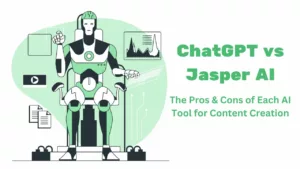
ChatGPT vs Jasper AI | The Pros & Cons of Each AI Writing Tool
Book a call with an digital strategist.
Send us an email
How to set up a travel social media marketing strategy
Written by by Jenn Chen
Published on December 17, 2019
Reading time 7 minutes
We’ve all seen the social posts: selfies from a beach vacation, airplane wings en route to a faraway destination and delicious meals in a different city. Through all the changes and growth that social media has experienced in the last decade, some things stay the same. Vacations are posted about in all of their stages: planning, sourcing recommendations and the trip itself. Social media plays an important role in all of this and travel companies should recognize it or risk stagnation.
Whether you’re a luggage company or a hotel, our tips should give you some ideas to test out on social. You’ll notice that a lot of the ideas are centered around content and that is because travel lends itself to a more visual audience. People want to see what the experience will be like and they need to see it often. Read on to find out how to take advantage of social media to get the message out about your travel or hospitality brand.
Basics: Set yourself up for success
If you’re starting your strategy from scratch or just looking to update your current one, taking a look at the resources available to you is always step one. You can’t manage four different social networks by yourself if you have a large and active audience. Responding to comments alone would take up a lot of your time. So what kind of resources are we talking about?
Staff is the most obvious one. How many people do you need for your company to successfully meet goals for sourcing and creating content, posting, managing comments and DMs and keep an eye out for complaints? Is your company large enough that you need a 24-hour watch on social media? Managing a single-location company is far more different than managing a multi-location one, especially if it spans multiple time zones.
The next basic resource to pay attention to is skill . This ties closely to staff because you want to make sure you have all the right skillsets to execute your strategy. And if you don’t, then you’ll need to be comfortable outsourcing. Social media managers tend to have a lot of different skills , including excellent communication and writing.
Third, get your budget in order. Ads are an important part of the travel industry. If you’re running flash deals on social media, ads are the way to go and you need to make sure you have the budget to promote them.
Lastly, document your strategy with goals . Without clear social media goals per network, your strategy will flounder. The best way to set these up is to evaluate your current audiences and see how they’re using each network. For example, if your customers like to use Twitter for direct customer service, set up goals on response time and a feedback loop of how well your responses are performing. Have a response plan in place for common questions and complaints.
Setup might take a while and you’ll go through several iterations in trial and error, but having a basic plan in place will save you wasted effort in the long run. Having a total picture of the resources available to you will help you know if you should be active on that additional social network or not.
Plan posts for each portion of the purchase cycle
For more expensive getaways and items, the purchase cycle will be longer. For travel brands, this means you’re playing the long game and need to make sure you have posts targeted for each stage.
At the beginning of 2019, Pinterest released their travel personas and trend report . It noted that “69% of Travel Pinners use Pinterest to discover travel services when deciding what to book.” The Pinners typically booked within two months of starting research and research included everything from what to bring to what to do.

Instead of directly promoting their services to customers, cruise company Carnival created a “Cruising Tips” Pinterest board for those still thinking about going on a cruise or have recently booked. The guides are a nice mix of what to expect when you go on a cruise to how to stick to your exercise routine.
It doesn’t matter if you’re a hotel or a travel backpack company. The principles of targeting consumers at each part of the purchase cycle remain the same. Don’t forget that you’re not done when they’ve made the purchase. You want to keep them constantly engaged and reminded of your product or service.
Understand different generations
Millennials and the younger Generation Z groups have more spending power now but to market to them, you’ll need to understand their social media use. An Expedia study of millennial and Gen Z travel behaviors found that they were heavily influenced by social media.

Eighty-four percent of Gen Z and 77% of millennials surveyed had been influenced by social media when planning their travel. More than 70% surveyed were open to help and inspiration during the planning process.

Both Gen Z and millennials named appealing imagery and deals as the two most informative pieces of social media content. Photos and videos maybe costly to create and produce but they will be worth it in the long run.
To ease the content sourcing pain, include user-generated content from past customers. This works particularly well for high-ticket purchases. Potential customers get to see what they’ll be buying through the lens of someone who’s already been. It establishes credibility to your brand so you’re not the only ones talking about you.
Walk into sophisticated spaces designed to expand the mind and spark new ways of thinking. / 🎥: @RonTimehin at @RdamMarriott pic.twitter.com/CIcsoioVx6 — Marriott Hotels (@Marriott) September 6, 2019
Marriott Hotels consistently uses user-generated content to promote its various hotel locations. They give glimpses into what it’s like to stay at a location. While some photos and videos on your account will be staged, you can bring in additional authenticity by reposting ones created by their guests.

Why your entire team needs access to social business intelligence
Respond to reviews
Reputation management is important in travel and this doesn’t mean only responding to complaints. According to a Harvard Business Review study with TripAdvisor, it found that once hotels started responding to reviews, they saw a drop in the amount of short negative reviews. Knowing that management was reading and responding to reviews made for more thoughtful posts.
In a 2019 study , TripAdvisor noted that 81% of respondents frequently rely on reviews before booking a hotel. Travel purchases represent a major investment of money, time and even the emotional expectations people place on anticipating a great vacation, so your audience depends on feedback from reviews and social media to figure out how to spend their money and effort. This is why staying engaged and responsive on both social networks and review sites is key to building a travel brand’s presence.

To make it easier on yourself, use Sprout’s new review management tool to respond to reviews on Google My Business, Facebook and TripAdvisor all in one place.
The next essential step is to create an online review management strategy . This involves coming up with tone, vocabulary and common scenarios that might need addressing.

Online reviews do influence consumer behaviors so it’s best to approach them like any compliment or complaint you might have in person. Be sure to respond in a timely manner, listen to what they’re saying, offer a resolution if you’re able to and e sure to avoid a defensive tone. Pretend that you’re being recorded and the video will be posted publicly for eternity–this will help you avoid lashing back at difficult customer feedback in the heat of the moment. Future customers will read your responses, so how you respond is important.
Divide & conquer
For multi-location businesses, it’s sometimes best to create separate accounts for your national and local brands. The national brands can amplify local messaging and connect with loyal brand advocates while the local brands can address in-the-moment customer service queries and promote their immediate area.
Following the lead of other large corporations, you may even set up a separate account to address customer service inquiries. All of this is up to your company and your available resources. For whichever circumstances you fall under, Sprout makes it easy for enterprise companies to post in a cohesive and collaborative manner. Divide your local branches up into groups but still give them access to your Sprout Asset Library .
Ace Hotel does a good job of creating a cohesive national brand presence while their local accounts focus on what’s happening in that location or city. Each local account also runs promotions to make following them more appealing to those who are thinking of booking.
The travel industry is large and encompasses many different types of companies. But whether you’re a single-location vacation rental or a multi-location global company, travelers still want to hear from you. Your best bet is to plan carefully and get creative. Take inspiration from other companies and be sure to invest in a strategy and professional imagery.
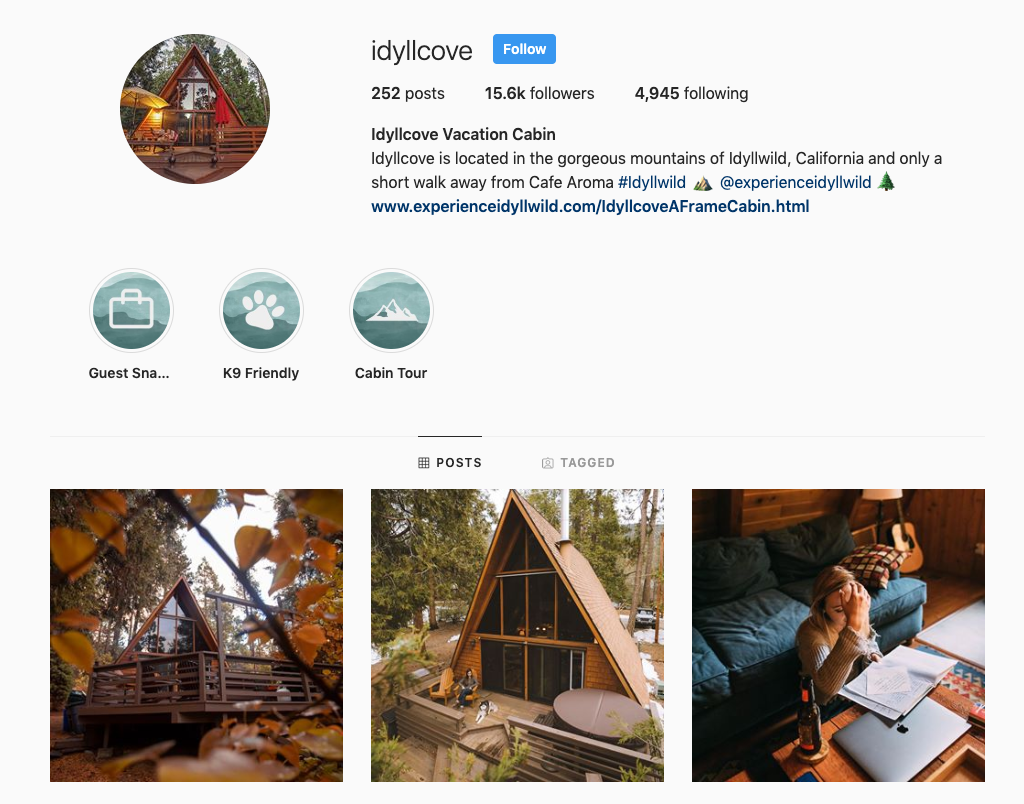
Idyllcove Vacation Cabin is a great example of one location doing their best at promotion. The shots posted are always on brand even when they’re user-generated content. To help potential visitors cement their decision, they created a highlight that tours the cabin. And the Guest Snaps highlight makes use of user-generated Story content.
Airbnb, on the other hand, is on the opposite end of the vacation rental spectrum. The company uses Instagram to highlight its many available places to book and what you can expect out of each one. In the above example, you can not only picture yourself there but you also get ideas on what you can do while you’re staying there.
Whatever your specialization is in the travel industry, the basic tenets are the same: get your basics down, respond to reviews in a timely and gentle manner and don’t forget the newer generation.
- Social Media Strategy
- Travel & Hospitality
Social media and hospitality: How 3 brands are serving 5-star experiences
- Customer Care
Sprout Social helps keep NJ TRANSIT’s social strategy on track
How Loews Hotels & Co succeeds at scale with Sprout Social’s all-in-one platform
- Now on slide
Build and grow stronger relationships on social
Sprout Social helps you understand and reach your audience, engage your community and measure performance with the only all-in-one social media management platform built for connection.

Travel agency social media strategy 101: A beginner's guide for travel agents
Last updated November 29, 2023
If you're wondering what a travel agency social media strategy is, you're in the right place. It’s a term that gets thrown around a lot, but it’s rarely defined.
Essentially, a travel agency social media strategy is a plan for how you'll use social media to achieve your business goals. And if you're a travel agent, having a social media strategy is more important than ever before.
In today's digital age, social media can be a powerful tool for promoting your business, building brand awareness, connecting with potential customers and getting them into your sales funnel. But without a solid strategy in place, your efforts may fall flat.
That’s why I’m walking you through the basics of social media strategy for travel agents. Whether you're a complete beginner or just looking to up your game, I’ve got you covered. So, let's dive in!
Disclosure: This post may contain affiliate links, meaning I may get a small commission if you decide to make a purchase through my links, at no cost to you.
Step 1: Define your goals and objectives
Before you start posting on social media willy-nilly, it's important to take a step back and think about your goals and objectives.
What do you want to achieve with your social media strategy? Do you want to increase your number of followers? Drive traffic to your website? Boost your bookings for a particular destination?
Once you've defined your goals, you can start to develop a strategy that will help you achieve them. And let's be honest, who doesn't love a good strategy?
As a travel advisor, your goals might include things like:
Increasing brand awareness
Building relationships with potential customers
Driving more traffic to your website
Generating leads and bookings
Whatever your goals may be, it's important to make sure they're SMART. That stands for Specific, Measurable, Achievable, Relevant, and Time-bound. SMART goals are more likely to lead to success, and less likely to leave you feeling overwhelmed or directionless.
Do you want to increase your social media followers by a certain number or percentage by a specific date? Maybe you’d like to connect with a specific number of leads, or get a certain number of bookings for a specific destination within a specific time period. Those are both examples of SMART goals.
So, take some time to think about what you want to achieve with your social media strategy. Then, write down some SMART goals to help you get there. Trust me, it's worth the effort.
Step 2: Know your target audience
Alright, time to get a little more specific. When it comes to social media, it's not just about getting as many followers as possible. It's about getting the right followers.
That's where knowing your target audience comes in. If you don't know who your ideal customer is, you'll have a tough time creating content that resonates with them and ultimately, driving more business.
Think about it: would you rather have 10,000 followers who aren't interested in travel or 1,000 followers who are itching to book their next trip? Yep, I thought so.
So, take some time to define your target audience. Who are they? What are their interests? Where do they live? What kind of trips do they like to take?
Once you have a good idea of who you're trying to reach, you can start to tailor your content to their interests and needs. And trust me, they'll appreciate it.
One way to define your target audience is to create a buyer persona or an Ideal Client Avatar. What are those? They’re simply a semi-fictional representation of your ideal customer. It includes things like their demographics, interests, pain points, and more.
To create a buyer persona, start by gathering data on your existing customers. Look at their age, gender, income, location, and more. Then, think about their interests, motivations, and challenges. Use this information to create a detailed profile of your ideal customer.
> Want a step-by-step guide and worksheet to make creating your Ideal Client Avatar easy? Click here!
With your target audience in mind, you'll be able to create content that speaks directly to them, build relationships with potential customers, and ultimately, drive more business.
Step 3: Choose the right travel agency social media platforms
Alright, now that you know who you're trying to reach, it's time to figure out where to find them.
There are a ton of social media platforms out there, and not all of them are right for every business. As a travel agent, you'll want to focus on the platforms where your target audience is most active.
So, which platforms should you be using? Here are a few of the most popular social media platforms for travel agents:
Facebook: With over 2.8 billion monthly active users, Facebook is a great place to connect with potential customers and share your travel expertise.
Instagram: With its focus on visual content, Instagram is perfect for showcasing travel destinations and inspiring your audience to book their next trip.
Twitter: Twitter is a great platform for sharing travel news and engaging with customers in real-time.
Pinterest: Pinterest is a visual search engine that's perfect for showcasing travel destinations and creating travel guides.
Of course, there are many other social media platforms out there, so it's important to do your research and figure out which ones are right for your business.
> Check out the Travel Advisor’s Guide to Social Media
When choosing which platforms to use, consider things like your target audience's age, interests, and their preferred social media platforms. You should also think about the type of content you want to create and how it will best be shared on each platform.
Remember, different platforms serve different purposes, so it's important to choose the ones that align with your social media goals and overall marketing strategy.
And don't forget to have fun with it! Social media is a great way to show off your personality and connect with potential customers in a more casual, human way.
Step 4: Develop a content calendar
Now that you know which platforms you'll be using, it's time to start creating content! But before you start posting, it's important to have a plan in place.
That's where a content calendar comes in. A content calendar is essentially a schedule that outlines what content you'll be posting and when. It's a great way to stay organized, consistent, and make sure you're always providing value to your audience.
Here's how to create a content calendar for your travel agency:
Start by brainstorming content ideas. What types of content will resonate with your audience? What questions do they have about travel? What types of destinations are they interested in? Think about these things and jot down some ideas.
Decide on your posting frequency. How often will you be posting on each platform? Make sure to choose a frequency that's realistic for your schedule and allows you to consistently provide value to your audience.
Choose a calendar tool. There are a ton of great content calendar tools out there, ranging from free to paid. You can even use your regular calendar and simply add your content calendar to it.
Fill in your content ideas on the calendar. Make sure to mix up your content types (e.g. photos, videos, blog posts, etc.) and be strategic about when you're posting certain content.
Schedule your posts, preferably in advance using a social media scheduler. I use and highly recommend Later , but no matter which one you use you’ll want to find one that works for you and start setting up your schedule.
A content calendar is a crucial part of any social media strategy, but it's also important to stay flexible and be willing to adjust your plan as needed. And remember, the goal is to provide value to your audience, so make sure your content is always informative, engaging, and helpful!
Step 5: Create engaging social media content
Now that you have a content calendar in place, it's time to focus on creating engaging content that will capture your audience's attention and keep them coming back for more. Remember, the goal is to provide value to your audience and build a relationship with them through your content.
Here are some tips for creating compelling content for your travel agency:
Know your audience. Make sure you're creating content that speaks to your target audience's interests and needs. Think about what types of travel experiences they're looking for and what questions they may have about travel.
Use visuals. Travel is a visual experience, so make sure your content includes eye-catching photos and videos. This will help your content stand out and grab your audience's attention.
Tell a story. People love stories, so use your content to tell stories about your travel experiences or the experiences of your customers. This will make your content more relatable and engaging.
Provide value. Make sure your content provides value to your audience. This could be in the form of travel tips, destination guides, or special offers on travel packages.
Mix up your content types. Don't just stick to photos or videos. Mix things up by including blog posts, infographics, and other types of content that will keep your audience engaged.
> Want to learn more about creating engaging travel content? Check out this post!
Some examples of engaging content for travel agents could include:
Destination guides
Travel tips and hacks
Customer testimonials
Behind-the-scenes looks at your business
Beautiful destination photos and videos
Remember, the key to creating engaging content is to put yourself in your audience's shoes and think about what types of content would be most valuable and interesting to them. By doing this, you'll be well on your way to building a loyal following on social media.
Step 6: Measure your social media success
After putting in the effort to create and execute a travel agency social media strategy, it's important to measure its success. Without tracking your progress, you won't be able to determine whether your efforts are paying off or if there's room for improvement.
To measure the success of your social media strategy as a travel agent, it's important to track relevant metrics such as engagement rates, reach, follower growth, and click-through rates. These metrics can give you insights into how your audience is responding to your content and how your strategy is driving traffic to your website or increasing bookings.
There are various tools you can use to track your metrics such as Google Analytics and individual social media platform analytics. If you use a scheduling service like Later you can also track many of your metrics there.
All of these tools can provide detailed reports on your social media performance and help you identify areas where you can make improvements.
Remember, measuring the success of your social media strategy is an ongoing process, and you should regularly review and adjust your strategy based on your metrics. This way, you can continually optimize your social media presence and achieve your business goals.
The bottom line
Congratulations, you now have a solid foundation for creating a successful travel agency social media strategy! Remember, having a well-thought-out social media strategy is key to standing out in a crowded industry and reaching your target audience.
As you embark on your social media journey, keep in mind that building a strong presence takes time and effort. Be patient, stay consistent, and don't be afraid to experiment with different tactics to see what works best for you.
Did you find this information valuable? If so, sign up here to get articles like this delivered directly to your inbox each week.
- Social Media
- Marketing Strategy
- New Travel Advisors
Recent Posts
Step by step guide: Defining your ideal client
The travel advisor’s guide to social media
Inspiring Wanderlust: How to Write Engaging Travel Agency Blog Posts

Plan & Book
Flight information, infinity mileagelands, business travel, please select your country / region of residence, travel news, advisory on eva air flights affected by runway closure at san francisco international airport.
Apr 30, 2024
Due to partial runway closures at San Francisco International Airport from April 30th to May 3rd, EVA Air flights departing from San Francisco International Airport will be affected. The flight numbers and schedules are changed as follows.
- 2024/04/30 Flight Status
- 2024/05/01 Flight Status
- 2024/05/02 Flight Status
- 2024/05/03 Flight Status
EVA Air advises that passengers check the Flight status for the latest information before heading to the airport.
This site uses cookies.
EVA Air's websites use cookies and similar technologies for the best experience on our website, including personalized services, ads and traffic analysis. These cookies include targeted media cookies and advanced analytics cookies. By clicking on "Accept", you agree to the use of cookies. You can change your cookie preference by clicking on the "Change your cookie settings" button.
For more detailed information on the cookies we use, please check our Cookie Policy .
Essential cookies are essential for the operation of our website that will let you move around our website freely and use functions on the websites. These cookies don’t gather your personal identifiable information that could be used for marketing and are not disclosed to any third party.

How a Marketing Strategy Can Expand Your Pool of Potential Home Buyers
An efficient marketing strategy is more important than ever for industry professionals in today’s digital world. Your website’s branding, content, social media, and design strategies are the gateway to meeting new potential home buyers and turning them into leads.
In NAHB’s upcoming online education courses during the month of May, learn how to use public relations, email marketing, photography and more to engage today’s consumers.
Expanding and Diversifying Business Opportunities May 2 | 1-4 p.m. ET
Examine more than 25 different opportunities in the construction industry that are ideal for building and diversifying your business.
How to Craft a Winning Digital Marketing Strategy May 7 | 1-4 p.m. ET
This course, designed for home builders, focuses on expanding your pool of potential home buyers through the use of multimedia communication strategy.
Website Best Practices for Maximum Lead Generation May 9 | 1-4 p.m. ET
Learn how to make key technology selections, build trust, and develop compelling calls to action that engage and convert potential home buyers.
Creating and Managing Qualified Sales Leads May 14 | 1-4 p.m. ET
Discover effective communication, prospecting, and evaluation skills to enhance your ability to identify the most qualified leads to help sustain your growth in any market.
Land Development May 28 | 1-4 p.m. ET
Learn the tips and tricks that will help you limit risk and maximize profit when finding land for small development projects.
Site Planning May 30 | 1-4 p.m. ET
Explore navigating governing authorities to sell for a maximum profit.
Save 10% by bundling the Land Development and Site Planning courses .
Subscribe to NAHBNow
Log in or create account to subscribe to notifications of new posts.
Latest from NAHBNow
May 01, 2024, apr 30, 2024, latest economic news.
The NAHB website uses cookies. We do this to provide a personalized experience, improve our content, and monitor the site performance. By clicking Accept you consent to NAHB’s use of cookies in accordance with its Privacy Policy . To learn more and control what cookies are used, go to Manage Cookies .
More From Forbes
Fashion brands embracing tech: what's next and what counts.
- Share to Facebook
- Share to Twitter
- Share to Linkedin
George Yashin, Founder and CEO of ZERO10 .
Over the past few years, fashion brands have been tapping into emerging technologies to enhance their marketing strategies, increase sales, attract new audiences and cultivate an innovative image. This shift isn't just about fashion becoming more advanced; it's also about technology offering unprecedented opportunities to achieve these objectives.
As the market evolves rapidly with new technologies constantly emerging and existing ones evolving, brands are actively exploring new tech and fine-tuning strategies based on real-world experiences and trials rather than mere predictions. What technologies have brands adopted thus far? And, most importantly, what are the key considerations for brands when adopting new tech?
Where Fashion Brands' Tech-Driven Strategies Are Headed
Major fashion brands have already been on their tech-driven journey for a few years. For example, Gucci’s metaverse collaboration in 2022 made history as the first luxury brand to create its own metaverse in The Sandbox. Similarly, Burberry and Lacoste announced their collaboration with Minecraft, showcasing collections inside the pixelated game world.
The results behind the campaigns revealed a positive effect of using new technology, both on customers' activities online and offline. Gucci alone made over $1 million in revenue by selling 100,000 digital Gucci items in the metaverse.
300 Billion Perfect Storm Bitcoin Price Crash Under 60 000 Suddenly Accelerates As Ethereum XRP And Crypto Brace For Shock Fed Flip
The top 10 richest people in the world (may 2024), major google leak reveals pixel 8a price and new 256gb model.
However, there's always a drawback to consider. While a technological approach may be more appealing to Generation-Z and Generation Alpha clients, who are accustomed to smartphones and value both virtual and physical assets, the same cannot be said for older generations, who prefer tangible products.
Some brands, such as Nike and Starbucks, have proven successful in the emerging tech field, introducing NFT programs and being proactive in Web3. However, despite successful implementation, they have had to slow down their investments in innovative solutions and rethink their strategies toward business goals.
Nevertheless, brands aren't giving up on technological advancements entirely. Instead, they are still looking to become more "phygital," creating mixed-reality experiences and integrating innovations inside physical spaces to satisfy and entertain all types of audiences. Ralph Lauren, for example, sold a limited-edition physical version of a digital boot that originally debuted within Fortnite, while Louis Vuitton unveiled a collection of NFT phygital trunks, offering an exclusive, unique experience to buyers.
AR mirrors, which allow customers to virtually try on products while retaining a connection to physical stores, can help modern retailers as brick-and-mortar shopping is expected to make up 85% of total sales in 2024. Brands like Coach have begun using AR mirrors in partnership with my company, ZERO10. Other examples include the AR mirror created through Tiffany & Co.'s partnership with Snap Inc. and the United States Tennis Association, allowing users to swing a digital diamond tennis racquet. The rise of Apple Vision Pro has further fueled interest in mixed reality. Brands like Alo Yoga, Gucci and Decathlon have launched immersive apps, offering real-life experiences to customers.
New Tech: Key Considerations For Brands
Based on my experience and discussions with others in the industry, we're all involved in building something new. We're all about gathering info, setting benchmarks and figuring out what performs the best based on what's happening in our projects and real-life scenarios.
When it comes to new tech, there's no substitute for getting hands-on and learning from actual experience. The more we dive into different cases, the better grasp we get on what truly works. For brands, it's crucial to factor these insights into their tech strategies.
Tech Trends: Balancing Innovation And Strategy
It's important not to rush into adopting technology solely because it's popular. The industry is evolving rapidly, especially with the recent introduction of generative AI, which is causing significant disruption.
For instance, there was a sudden surge of interest in the metaverse, with everyone rushing to establish a presence. However, media reports quickly shifted, declaring the metaverse dead, only to see it revived with a stronger focus on gaming—all within two years.
This fast pace leads some brands to embrace new trends immediately, hoping to be early adopters. However, brands need to ensure that technology adoption aligns with their goals. Merely embracing technology for novelty's sake isn't enough. Brands must define clear objectives or hypotheses to test the effectiveness of new tech initiatives. While creating new experiences with technology is exciting, integrating it into a broader strategic framework is crucial to drive tangible results.
Considering The End User
Brands must understand their customers when introducing new technology, considering factors like age and preferences. Without guidance, customers may ignore or react negatively to unfamiliar tech. So, it's critical not only to implement but also to educate them on its use and benefits. While some are tech-savvy, others need more help. Brands adopting tech want to speak the same language as their core audience, but what about the rest?
Some brands focus on image and publicity but overlook the needs of their end users—their customers. Technologies with simple interfaces, especially when integrated into familiar environments like physical stores, are more readily accepted among the wider audience. However, digitally exclusive technologies may require customer education. For instance, after actively launching NFTs or crypto wallets, some brands started providing glossaries or other activities to help customers understand their applications.
Why Technology Isn't A Cure-All Solution
One common mistake brands make is assuming that adopting technology alone will boost sales or enhance their image. When results fall short, or tech doesn't perform consistently, brands often treat it as a one-time effort and move on.
This reaction is understandable, given the pressure for quick results and high ROI in big corporate settings. However, successful tech integration, like traditional marketing, involves various factors, from staff training to data processes. In my experience, tech integration isn't a standalone task; it requires planning and clear communication.
Moreover, successful collaboration between tech vendors and brands is crucial. Both parties must commit to achieving great results and be open to adjusting strategies as needed. Work closely with brands on their journey, from design to promotion planning. Considering multiple factors and aligning efforts ensures maximum effectiveness every step of the way.
Forbes Technology Council is an invitation-only community for world-class CIOs, CTOs and technology executives. Do I qualify?

- Editorial Standards
- Reprints & Permissions

IMAGES
VIDEO
COMMENTS
Your travel marketing strategies can span social media, paid marketing, local content, seasonal SEO, content marketing, and beyond. Customer personas are important for effective travel marketing. For example, our survey data shows that 88% of people either try somewhat (45%) or very hard (43%) to save money while traveling. This kind of data is ...
In conclusion, these 20 travel website marketing strategies for 2023 offer actionable tips to help you grow your travel business online. Embrace the power of social media, influencer marketing, user-generated content, and advanced technologies to attract and engage travelers, ultimately converting them into loyal customers. ...
4. Retarget people who have shown interest. Travel is a big purchase, and people are unlikely to make a decision the first time they land on your site. Use Facebook remarketing to target consumers who have visited specific pages on your site or have shown an interest in a specific hotel room, date, or activity.
13. Host a giveaway. If you are planning to use email marketing and to build your email list to promote your travel website, I highly recommend you to start it with a giveaway. It is also a great way to get some hype on social media. Giveaway is probably the best way to collect email addresses if you are just starting.
Whether traveling for business or leisure, going by air or train or car, the desire to travel is real. Telling your target audience how you will be providing value and keeping them safe is essential. Step #1, know your audience. Step #2, connect with them. Step #3, embrace a multi-channel strategy.
Travel Search Marketing. There are two categories of search marketing: paid search through Google AdWords or Bing ads, and search engine optimization (SEO). We focus on SEO so that's what we'll be talking about here. What you want to think about with travel search marketing is the life cycle of a visitor.
In today's highly competitive travel industry, having a robust marketing strategy is crucial to stand out from the crowd and attract potential visitors.Whether you are a destination marketing organization (DMO), travel agency, hotel, or tour operator, understanding the importance of a comprehensive travel marketing strategy is key to your success. In this article, we will explore the role of ...
4. Upgrade Your Social Media Game. Social media is an integral part of any marketing strategy for 2023 and beyond. With the growing popularity of platforms like TikTok and Instagram, travel companies can leverage their social media following to increase bookings and drive traffic to other marketing channels.
About 70% of consumers prefer to know about a company via content. Similarly, 72% of marketers think branded content is more effective than advertising. These stats prove that focusing on content marketing strategy is the need of an hour for travel or any other industry. Most travel operators already know that content is the best way to drive high-value traffic to travel websites and generate ...
Building an email list and creating an automated email drip campaign is one of the most effective content marketing strategies for travel websites. By collecting email addresses from your visitors and customers, you can stay in regular contact with them and promote your latest content, deals and special offers.
2. Understand your audience. Within the overall market, travel agencies must clearly define their target audience. Use identifiers such as age, gender, family size, earning potential, location, etc. You can also create elaborate buyer personas to guide your digital marketing efforts. 3.
Basically, the high-level, strategic goals of modern travel agency marketing are clearly articulating a narrow segment that you address (lower prices in specific destinations, traveler region, demographics, etc.) and choosing the best tools to promote the service. So, let's start with understanding customer segments.
A comprehensive digital marketing strategy for tour operators must include content marketing, social media marketing, SEO, email marketing, and mobile optimization. These strategies create an effective online presence and drive the agency's website traffic. Social media marketing is vital for travel agencies: It allows them to engage with ...
An effective travel agency marketing plan tailored to your niche and target market is essential for maximizing your ROI. This article provides 8 updated tips and best practices for creating a successful marketing plan that resonates with customers and drives growth in the travel industry. Let's go! Personalize Your Website, Content, and Services
Let us explore the top 20 digital marketing strategies for 2024 below:-. 1. Develop a user-friendly website. A user-friendly website is an essential part of a digital marketing strategy for travel brands in 2024. Having a good mobile-friendly website helps in many ways.
The core objectives of travel marketing are to raise awareness, spark interest, and ultimately drive bookings for travel services offered by travel agencies, online travel agencies, tour operators, and travel companies. Through a meticulously crafted mix of digital marketing tactics—including social media marketing, email marketing, content ...
6 marketing ideas for travel and tourism. Here are some travel marketing campaigns you can implement: Have a well-designed website. Create a robust content marketing strategy. Optimize your website for search. Harness the power of social media ads. Collaborate with influencers.
Travel marketing ideas; A travel marketing plan; Travel agency ad examples; And leave a marketing ninja, not really. But you will be wiser. 😉. Marketing for Travel Agents Tips. Have a Unique Selling Proposition (USP) Know where you differentiate and sell that. This could be customer service, affordability, quality, or speed.
At The Savvy Travel Advisor we specialize in helping travel advisors grow their travel company through custom websites, website copy, and marketing strategies. If you're ready to take your marketing efforts from haphazard to simple and clear, contact us and let's get started! Marketing Strategy. •. New Travel Advisors.
An Expedia study of millennial and Gen Z travel behaviors found that they were heavily influenced by social media. Eighty-four percent of Gen Z and 77% of millennials surveyed had been influenced by social media when planning their travel. More than 70% surveyed were open to help and inspiration during the planning process.
Best Marketing Ideas for Travel Agencies. 1. Use content marketing and effective copywriting with Jasper.ai. 2. Use Search Engine Optimization to organically drive leads with Surfer SEO. 3. Put your email list to work with Constant Contact. 4. Develop a content marketing plan with WriterAccess.
Here are a few of the most popular social media platforms for travel agents: Facebook: With over 2.8 billion monthly active users, Facebook is a great place to connect with potential customers and share your travel expertise. Instagram: With its focus on visual content, Instagram is perfect for showcasing travel destinations and inspiring your ...
KEYWORDS. Travel agency's website marketing, Marketing mix strategy, Integrated theory of 4C and 4P. ABSTRACT. For the travel agency, its website is not only the tool of marketing, but also is a special product provided to tourists. So it is necessary for travel agency to develop the website marketing strategy scientifically and systematically.
Improving small business marketing strategy. The small businesses in the report know they're missing significant opportunities to market their companies. And they plan to do better this year. In ...
Having a quality website is imperative. Statistics show that 71% of businesses had a website in 2023—and a further 43% of small businesses plan to invest in their website performance. Whether ...
The published version of Forbes' CMO newsletter delivers the latest news for chief marketing officers and other messaging-focused leaders to inboxes every Wednesday.
EVA Air's websites use cookies and similar technologies for the best experience on our website, including personalized services, ads and traffic analysis. These cookies include targeted media cookies and advanced analytics cookies. By clicking on "Accept", you agree to the use of cookies.
A B2B SaaS marketing strategy must be customized to fit a company's unique goals and resources. It should evolve with market changes and technological trends to effectively reach the target ...
An efficient marketing strategy is more important than ever for industry professionals in today's digital world. Your website's branding, content, social media, and design strategies are the gateway to meeting potential home buyers and turning them into leads. An efficient marketing strategy is more important than ever for industry ...
Over the past few years, fashion brands have been tapping into emerging technologies to enhance their marketing strategies, increase sales, attract new audiences and cultivate an innovative image.